- CruiseMapper
- Ships and Lines

Cruise Ship Engine Power, Propulsion, Fuel
These are some of the most interesting cruise ship technology-related data and facts - engines , power , marine propulsion systems , fuel consumption of cruise ships , and something about pollution (in-article navigation links).
In 2020, IMO (International Maritime Organization) implements its global 0,5% sulfur cap on marine fuels. If not using scrubbers (pollution control devices), owners of older vessels must use as ship fuels either MGO (marine gas oil), ECA Category Fuels (low sulfur MGO), new modified fuels and blends, LNG (liquefied natural gas) or electric/battery power . Each fuel option is based on vessel type and age, routes/itineraries and powerplant. Most newbuild passenger ships are LNG-powered . World's largest seaports plus numerous smaller ports already have installed shoreside power capabilities providing shore-to-ship power supply to berthed vessels. In many ports, shorepower is in addition to LNG bunkering capabilities.
Cruise Ship Engine
Without a source of power, these huge cruise vessels would be nothing more than drifting aimlessly hotels. A large number of older ships use diesel reciprocating engines for generating power for propulsion. Cruise ship engine power is supplied through the transmission to the propeller shafts. These transmissions determine the revolutions of propellers. Modern ships use either diesel-electric engines or gas turbines as a source of power for propulsion, and for ship's systems. Some of the larger ships depend on two power sources - one for electrical power and one for propulsion.
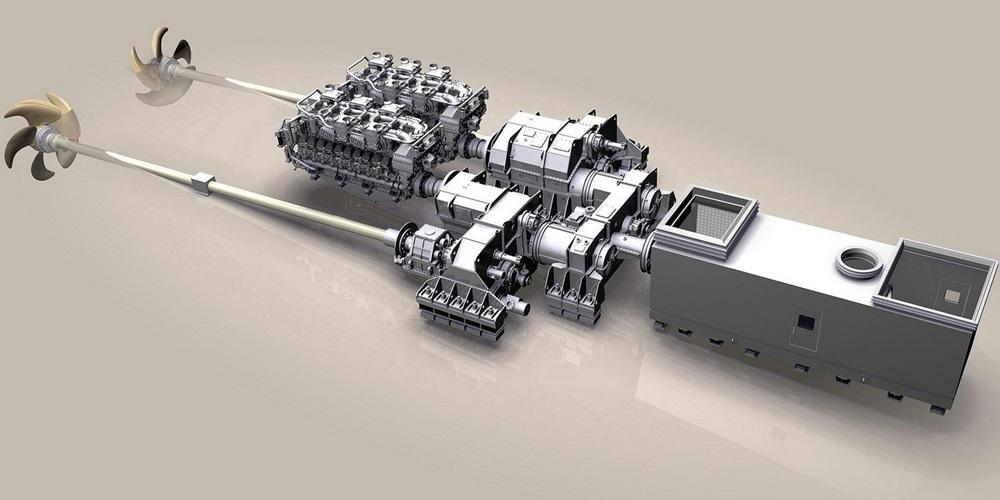
Gas turbine engines (being aero-derivative) generate heat which is transformed from mechanical energy into electricity. To achieve this, compressed air is fired in a combustion chamber. Hot exhaust is made over a turbine that spins to drive mechanically a shaft. The power can be used to spin the generators. The same way works diesel-electric engines, yet they use a direct drive system, not a turbine. The output shafts, to produce electrical power, are connected to generators.
Both engine types need a lot of fuel. Cunard QE2 , for example, consumes daily 380 tons of fuel when traveling at 29 knots speed and carries fuel enough to sail for 12 days. Usually, ships fill up at various seaports and use fueling barges as floating gas stations. Vessels use lower-grade diesel which tends not to burn as purely as diesel-powered road-going vehicles.
All ships rely on propellers/screws to be pushed through the water, providing forward and reverse motion. Airplanes, for example, require tremendous propeller speeds to provide the forward motion, but ship propellers don't need to turn so fast and rely on torque power. Therefore, ships travel slowly and rarely top 30 knots (for more info follow our speed-link above).
Cruise ship engine room
The basic detail about the cruise ship engine room is its location. For stability, the ship's heaviest weights are at its lowest possible deck, and usually, engines are mounted above the keel. Ship's lowest decks are almost entirely full of machinery. An area creating enough power for driving such an enormous vessel through water needs to be really big - very often engine rooms occupy at least three decks. Rather than long halls stretching the length of hulls, machinery is almost always divided into smaller compartments - one for the main engines, another for the heating/air-conditioning system. This compartmentalization is for safety reasons. If a penetration to the hull or fire happens, multiple compartments help contain the damage. The next photo shows the engine room of RCI's Oasis-Class vessels.
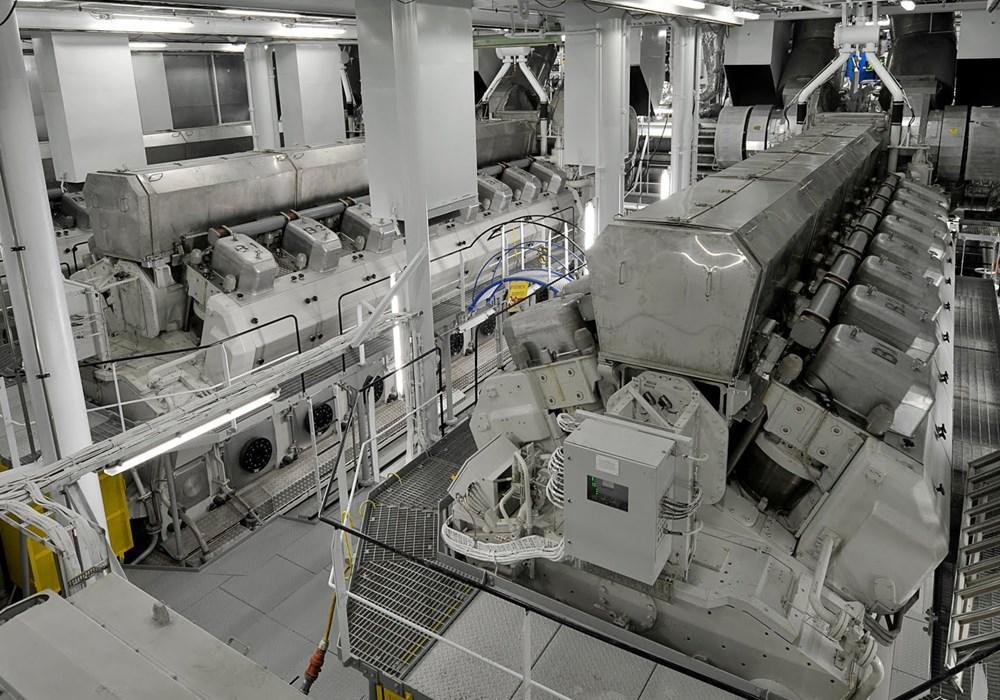
Rarely, engines are not placed at the ship's bottom. RMS Queen Mary 2's four main diesel engines are above the keel, with two smaller gas turbines on top-deck (aft of the funnel). It was not unusual for older liners to have 2 engine rooms. Gradually, technology allowed the consolidation of these spaces. However, current maritime legislation requires vessels to have equipment duplication and 2 engine rooms.
In May 2015, Wartsila Corporation and Carnival Corporation partnered to optimize cruise ship engine room operations of all 101 ships across the corporation's 9 brands. The deal was signed by Micky Arison (Carnival's Chairman) and Bjorn Rosengren (Wartsila's President and CEO). The plan included installing Wartsila's latest marine solutions, first tested on several Carnival Cruise Line vessels in pilot projects. The new systems and technologies included engine control and monitoring systems, safety and fuel efficiency equipment.
Wartsila's "Asset Performance Optimization Solution" package allows obtaining optimal performance from Wartsila marine diesel engines, recommends how to deal with potential issues, maximizes ship performance, ensures full-capacity systems operations, increases the predictability of fuel management and maintenance needs. Wartsila's fuel engine package was specifically designed to reduce fuel consumption.
Wartsila Marine technologies aim to optimize ship performance, but also allow to locate deviations from normal parameters of equipment and engines. This allows emerging problems and engine fault sources to be fixed before they occur.
Conventional diesel cruise ship engine
Today's direct-drive diesels feature one main advantage - the option to use a shaft generator, which is a device using the circular motion of the propeller shaft in order to generate the electricity needed for hotel services, like cooking and lighting.
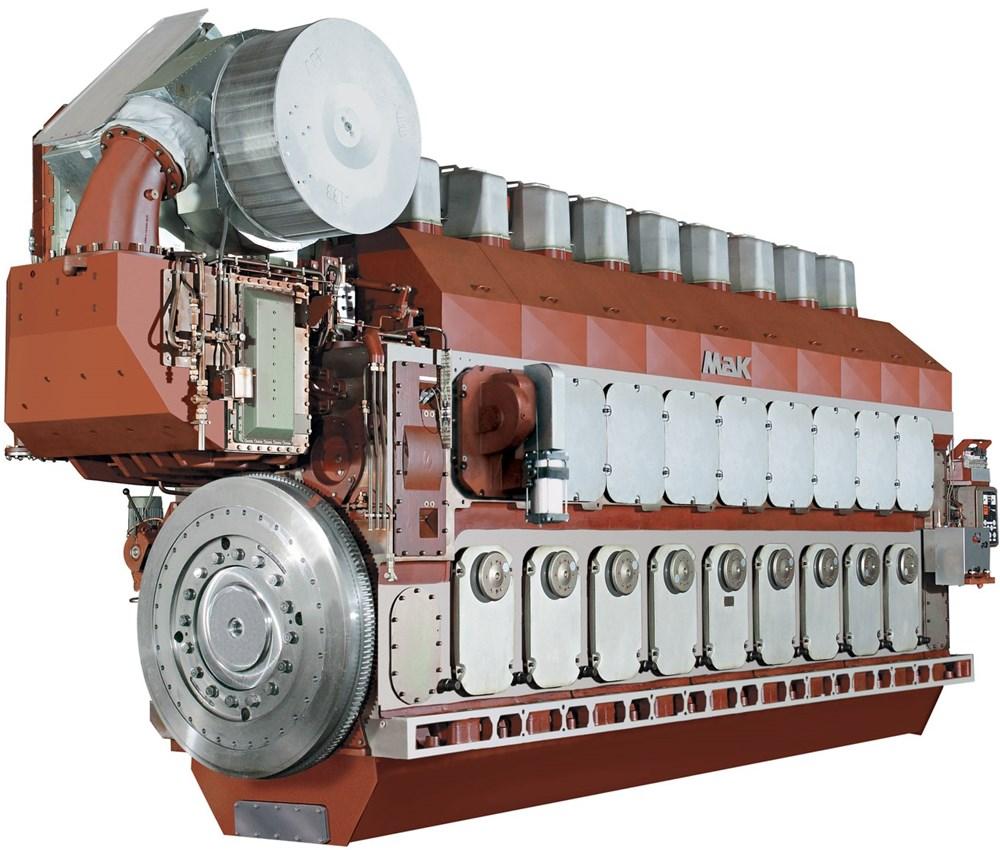
Shaft generators can be used only while the ship is moving with a fairly constant cruising speed. This is what the NCL Epic cruise ship engine looks like:
Diesel-electric cruise ship engine
Almost all new ships feature a diesel-electric propulsion form. On these ships, main engines are not connected to propeller shafts, and instead of it they are directly connected to big generators in order to produce electricity, which is sent in turn to electric motors, that then power and help turn the propellers. The main advantage of the diesel-electric cruise ship engine systems is efficiency as they allow main engines to operate near the most efficient speed, no matter if the ship is moving at 5 or 25 knots.
Losing electrical power is devastating to ships. Main engines and generators require electricity and it's needed to keep them going. Pumps that are driven electrically take in cold ocean water to cool the engines and electrical pumps get fuel from fuel tanks and supply it to the engine. Electrical power is vital for many operational functions - without it, ships come to a halt.
Large equipment (propulsion motor, bow thrusters) requires electricity of high voltage. As for smaller machinery (cabin lights, galley equipment), the electricity goes through the transformer and is thus stepped down into lower voltage. Large cables snake through all the ships to distribute electrical power. They carry power from generators to switchboards, through passageways, public rooms, crew and passenger cabins. Cabling can be a weak point in the distribution system. If the electrical cables aren't truly redundant, even ships that feature two engine rooms suffer power failure.
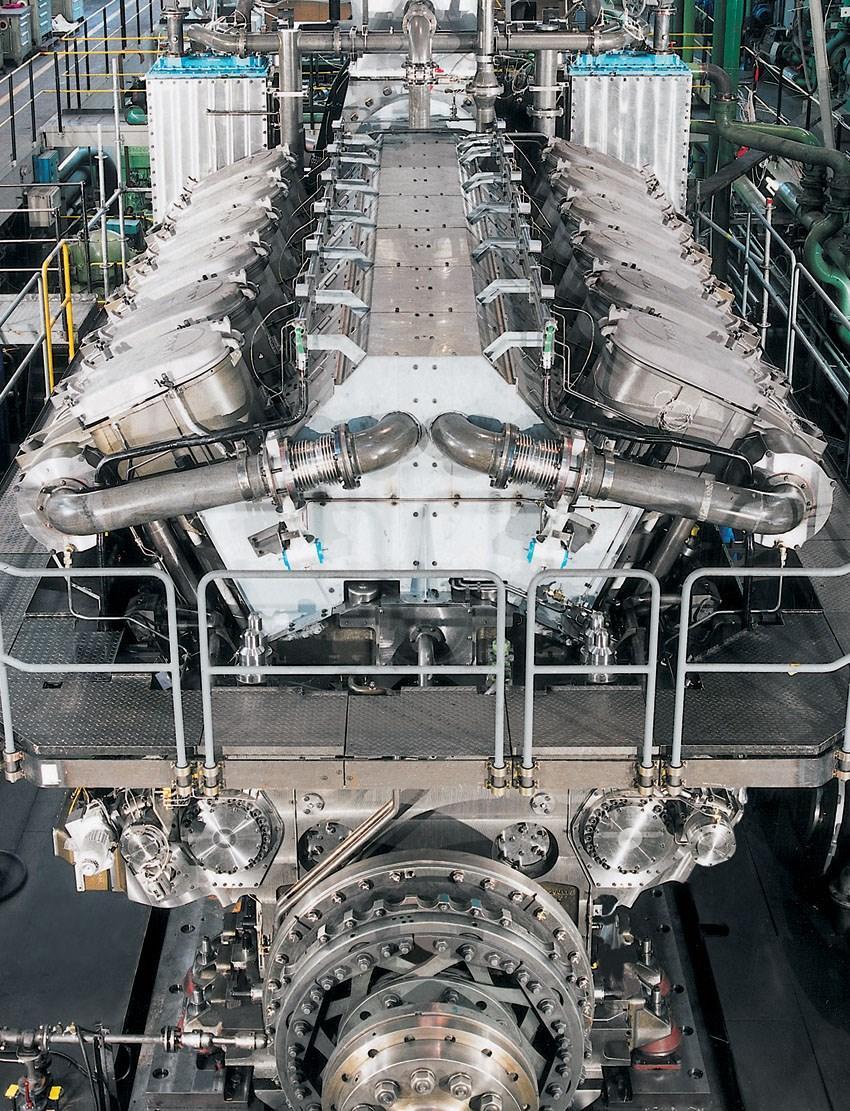
While ships are docked, generators and main engines produce more power than needed. They are turned off in port, and smaller generators supply "hotel" loads (lights, air-conditioning, galley, etc.). Moving through water takes up the vast majority of the ship's power needs - about 85% of all the diesel-electric powerplant production is consumed by the propulsion system. The above photo is of the Vista-class Carnival cruise ship engine room. The engine type is "MAN 2 times; 14V48/60CR" (common-rail diesel injection system):
Cruise ship Emergency Generators
All ships are supplied with emergency generators to maintain vital electrical power. Backup generators are located higher up and also outside engine room spaces to isolate them from damage or fire.
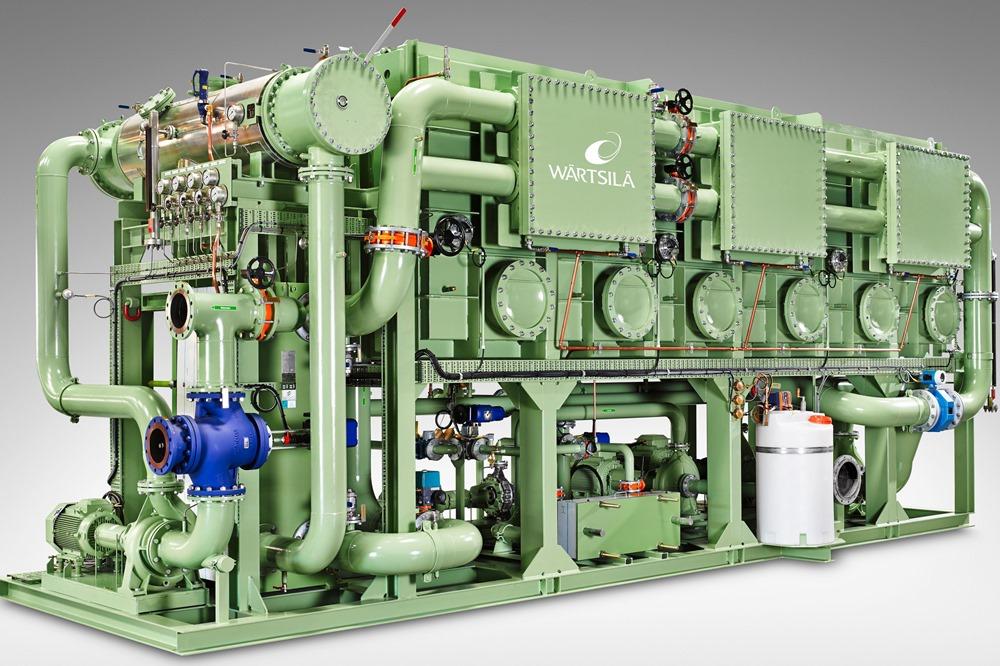
Big ships require much power, so they might have more than one emergency generator. Despite that, they don't have the capacity of main generators and engines, don't produce electricity enough to move the ship, and can't supply all the power needed in ports, because of constraints in space.
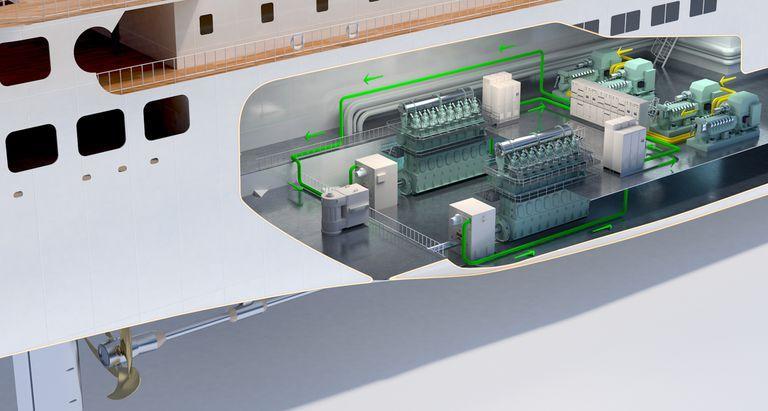
Emergency generators are instead used only for essential navigation systems - crucial communication equipment, critical pumps in the engine room, emergency lighting. Should they also fail, vessels are required to have a battery backup. 24 hours of power are at least provided by battery rooms to the smaller emergency equipment list.
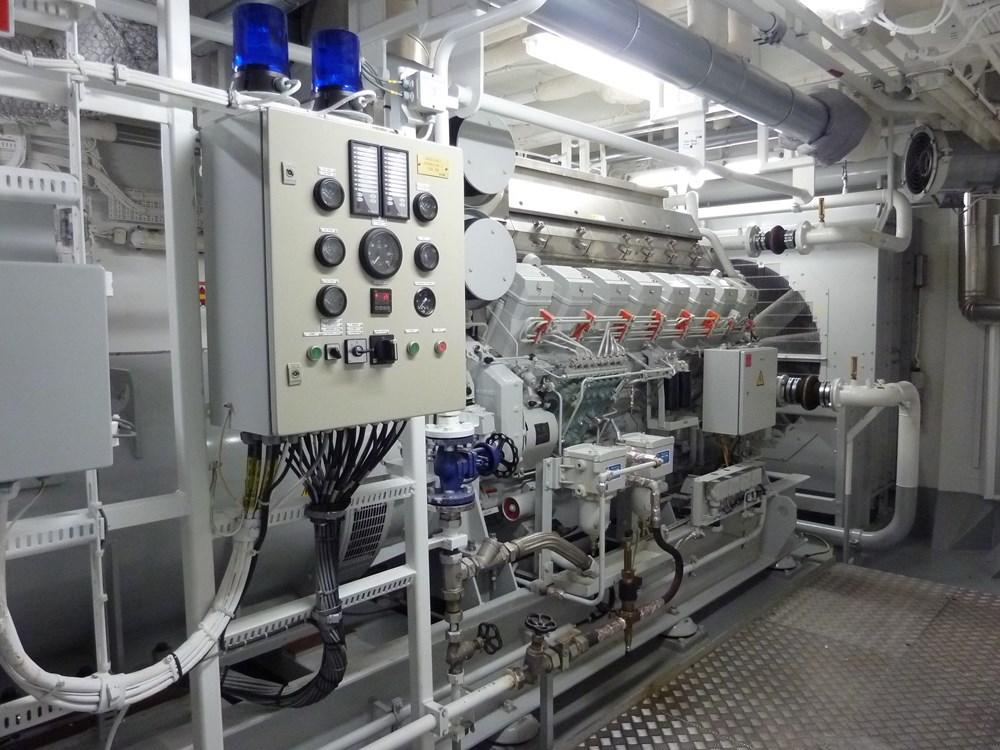
Probably you've heard about Carnival cruise ship accidents related to power failures in 2013. At our Carnival Fun Ship 2.0 upgrades link you can learn how CCL battled with this "unmaintained ships" image and implemented revolutionary new technology initiatives fleetwide - including an additional emergency backup generator on each of their vessels.
Cruise Ship Propulsion
The new cruise ship propulsion systems ABB Azipods XO (below photo) are more fuel-efficient than traditional systems, also providing better maneuverability, maximizing speed, reducing bad emissions, which as a whole optimizes ship's performance and enhances passenger safety.
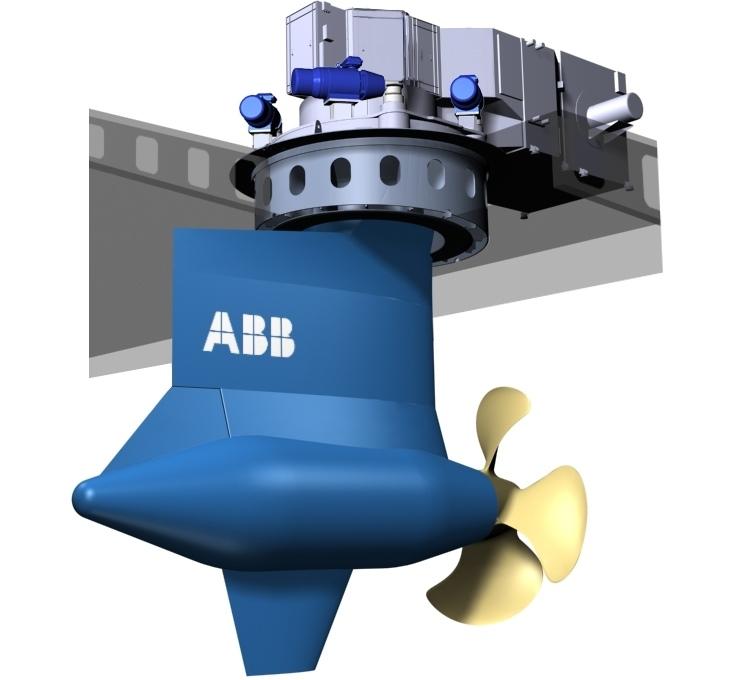
ABB Azipod propulsion systems have a major impact on the vessel's operating efficiency - reducing energy consumption and bad emissions by up to 20%.
In 2019, ABB signed a deal with Oldendorff Carriers (1921-founded, Germany's largest bulk shipping company with a fleet of ~700 ships) for the supply and installation of Azipod propulsion systems on two newbuild carriers. Both self-unloading dry bulk vessels were China-built (by Chengxi Shipyard Co Ltd / subsidiary of CSSC) and scheduled for deliveries in 2021. Each vessel was fitted with two Azipods (power output 1,9 MW per unit) plus various related electric and digital solutions (powerplant, diesel-electric generators, bow thruster motors, transformers, switchboards, power management system, ABB Ability global ABB real-time monitoring).
Azipod cruise ship propulsion system
Azipod cruise ship propulsion system is situated outside the hull in the aft of the ship. Azipod turns in all directions (360 degrees) by a rudder, providing thrust in any directions, not possible for conventional systems.
See at the first photo at right RMS Queen Mary 2 's propulsion system scheme.
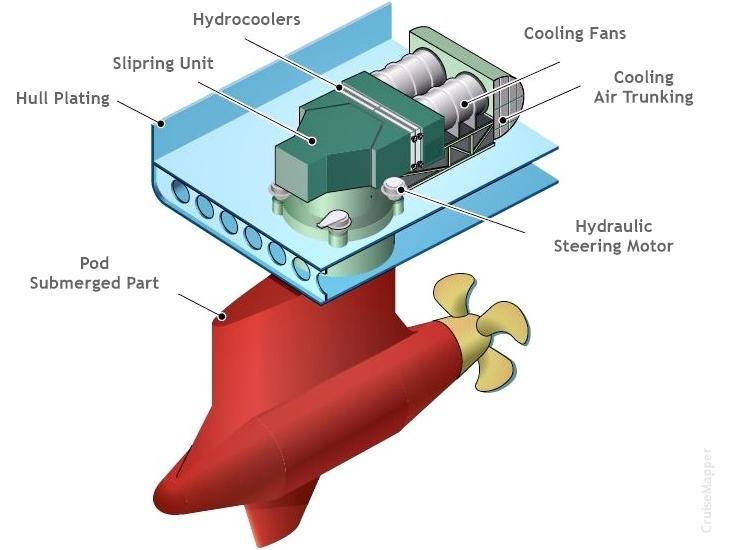
QM2's Azipod is actually an electric propulsion system consisting of the following main components:
- Propulsion motor - used to produce or drive thrust. The propeller's rotating is powered by an electric motor.
- Supply transformer - power produced by generators is 6600 KV, which is stepped down to the necessary voltage by supply transformer and is provided to the motor in the pod.
- Frequency controller - used to change the frequency of supplied power so that the rotating motor speed can be controlled.
Azipod marine ship propulsion is a combination of both steering and propulsion systems. Conventional marine propulsion systems use a two-stroke engine connected to a shaft, that passes through a stern tube and shaft tunnel to connect to the propeller outside the hull in the ship's aft/stern. This system's steering is done by a rudder (in the propeller's aft).
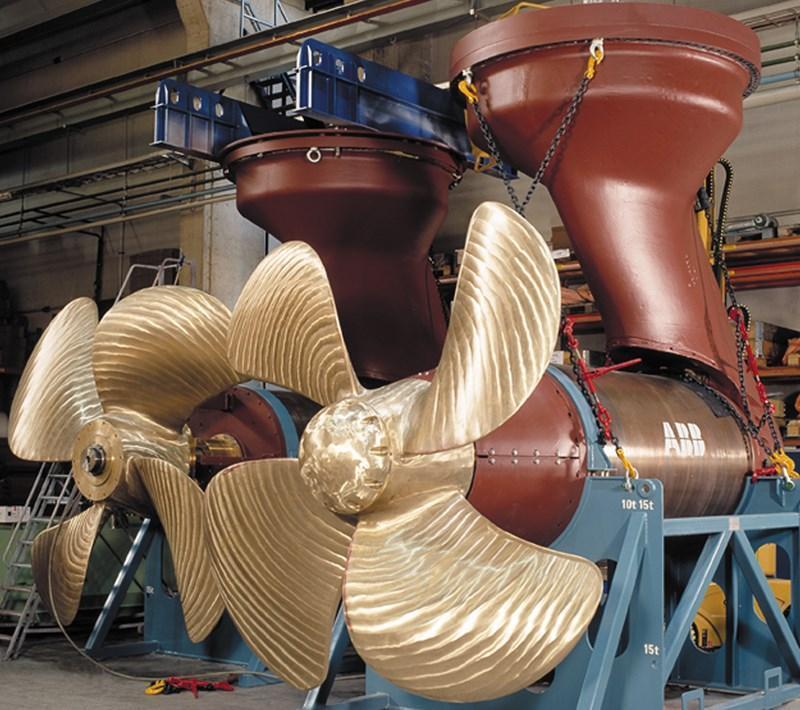
The above photo shows Oasis-class ship propulsion Azipods (2 units) before being mounted onto the hull. The next photo shows the Azipods (both units) mounted on the hull.
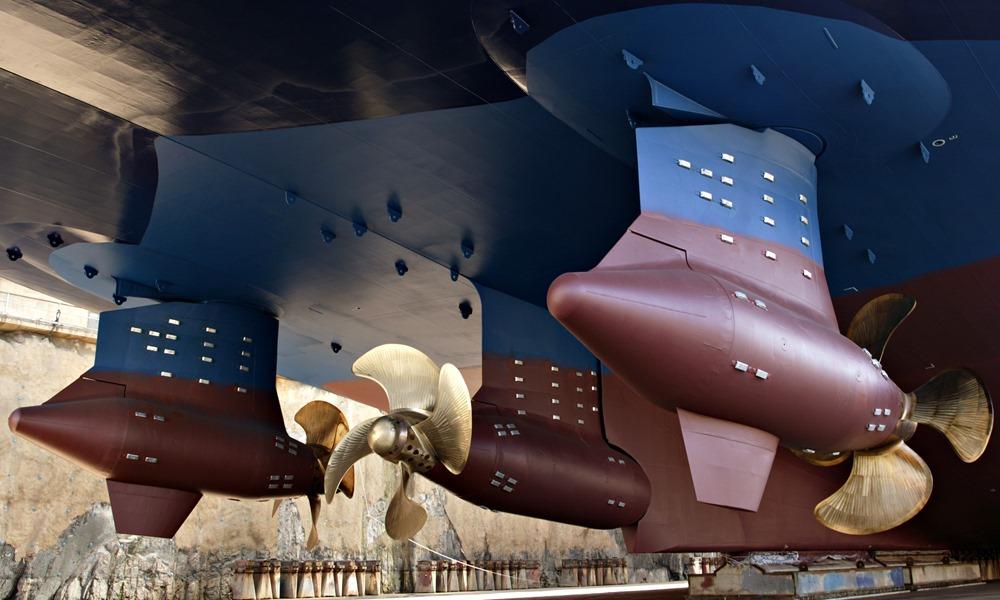
The 3rd Oasis-class ship - Harmony of the Seas, is currently the most technologically advanced and energy-efficient cruise vessel ever built. It is equipped with a new-generation exhaust gas cleaning system (multi-stream scrubbers) and also features a hull lubrication system allowing the ship to float on air bubbles (created around the hull) thus reducing drag and increasing fuel efficiency.
However, the steering and propulsion systems in Azipod arrangement, are combined into one part and the system consists of a propeller (driven by an electrical motor) turned by a rudder connected to the azipod system. The motor is inside the sealed pod and connected to the propeller.
The following YouTube video is about ABB Azipods installed on the new Genting Hong Kong vessels (Star Cruises' new ships and on Crystal Cruises' polar-class boats).
These ships incorporate a complete ABB propulsion - Azipods, electric power plant, computer automation, and software. Crystal cruise ships are powered by two "Azipod D" units allowing navigation in polar destinations. Each of the Star Cruises "Global-Class" vessels have three "Azipod XO" thrusters. All ships have installed ABB's "Intelligent Maneuvering Interface" and the "OCTOPUS" software optimizing fuel consumption and energy management. All these ships were constructed by the German shipbuilder MV Werften. Currently, almost 2/3 of all large-sized cruise vessels, icebreaking ships, and high ice-class cargo ships are with Azipod propulsion.
Advantages of Azipod propulsion marine systems
- A lot of space is saved by the Azipod cruise ship propulsion system in the engine room - there is no propeller, engine, shafting or other arrangements. This saved space can be used for storing cargo.
- Great maneuverability - the propeller can turn in all directions and enables crash maneuvering stop distance that is better than the conventional systems.
- Azipod cruise ship propulsion system can be placed below the ship's height and provide more efficiency than conventional systems.
- In case the ships have large breadth, two (or more) azipod systems, independent from one another, can be used to provide subtle maneuvering.
- Side thruster's use is eliminated as pods can be used to provide side thrust.
- Low lube oil and fuel consumption.
- Lower vibrations and noise than conventional systems.
- Because emissions are low, it's environment-friendly.
Disadvantages of the Azipod marine propulsion
- It requires great initial cost.
- Many diesel generators are needed for producing power.
- The power produced by the motor is limited - the maximum available power now is 21 MW.
- Azipod cruise ship propulsion systems can't be installed in heavy cargo ships that need large motors and a lot of power.
Royal Caribbean Quantum-class cruise ships propulsion
In April 2012 ABB made a USD 60-million contract to provide the Azipod propulsion systems for the new Royal Caribbean ships of the Quantum-class (Quantum, Anthem, Ovation) and Quantum Plus-class (Pulse, Passion). The former name of this vessel design was "Project Sunshine". Builder is Meyer Werft (Papenburg, Germany).
ABB also supplies the power generation, distribution systems, bow thrusters, and of course, the 2 x 20,500 kW propulsion Azipod XO units (at the photo at right), transformers and drives.
NCL Epic ship pod-propulsion
When entering service in 2004, the Cunard's QM2 was the biggest in the world at 150,000 GR tonnes. Her designer Stephen Payne showed the advantages of pod-propulsion giving vessels increased maneuverability. The propellers (screws) of the QM2 ship are mounted on the pods which rotate 360 degrees and provide advanced maneuverability. He made the choice to put pods - though relatively new and yet untested for big ships. Royal Caribbean vessels of Oasis, Freedom, and Voyager classes have pod-propulsion as many other big ships, which is opposed to the fixed traditional screws which push in one direction only.
An interesting fact about cruise ship propulsion is that Norwegian Epic doesn't have pods, though slightly bigger than Queen Mary 2 (at 153,000 GR tonnes), because of NCL concerns about the new technology. Some of the lines (including Celebrity and Cunard) have suffered vessel breakdowns due to pod-bearing failures. Lots of voyages had to be canceled, extensive dry-docking periods were required for pod bearings to be replaced, and NCL didn't want to take the risk.
Currently, NCL Norwegian Epic has two rudders with conventional non-Azipod screws. But how does she manage to maneuver if they can push in one direction only? One option is to make them bigger and more effective when maneuvering, another is to add additional mini-pods or install full-sized pods. Only time will tell if any of these will actually ever happen.
Rolls-Royce cruise ship propulsion system "Promas Lite"
In November 2013, the manufacturing giant Rolls-Royce upgraded Hurtigruten's ship MS Richard With its new "Promas Lite" propulsion system (integrated propeller-rudder system). This is an older ship, and Promas Lite was the perfect choice as it is a combined "propeller-rudder" system increasing the efficiency of older passenger vessels with lesser tonnage. The upgrade significantly reduced Hurtigruten's operating costs on this vessel. The improved propeller efficiency was estimated to be between 11-14% at a cruising speed of 15 knots (17 mph / 28kph).
Promas propulsion integrates propeller, hubcap, rudder bulb and the rudder into a single unit which can increase propulsion's efficiency by 3-8% (1-screw vessels) and by 2-6% (2-screw vessels). It also improves maneuverability, reduces fuel consumption and bad emissions. The new modular technology allows efficient and cost-effective custom-made systems to be built up from various existing and standard parts - mooring winches, anchor cable lifters, warping heads.
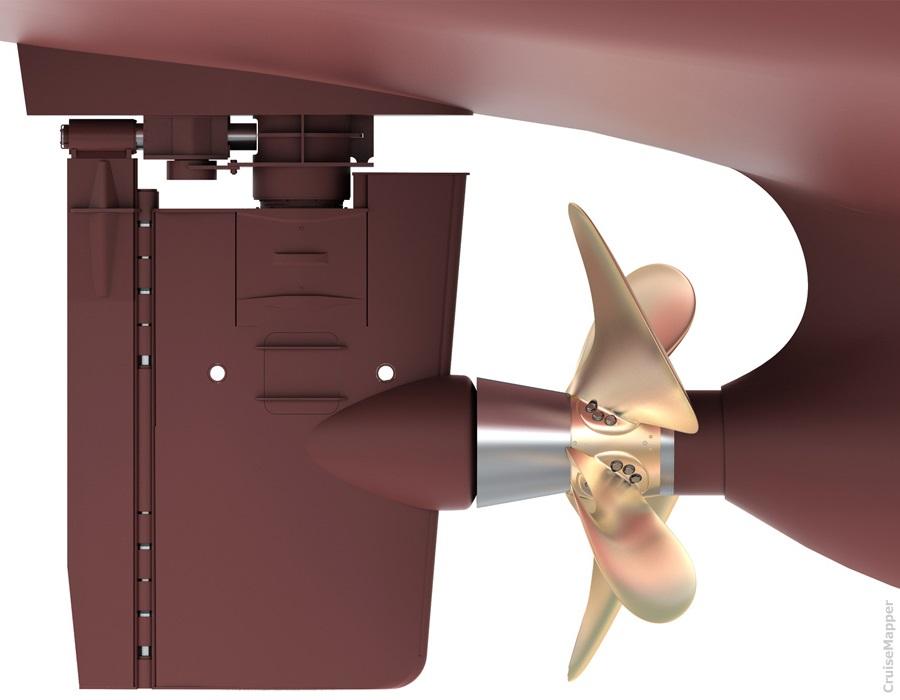
Hurtigruten was compensated with ~80% of its total investment in Promas Lite marine propulsion upgrades as the Norwegian Government has this NOx fund encouraging shipowners and operators to upgrade their vessels and invest in new marine technologies that reduce NOx emissions. The Promas Lite propulsion future clients, besides passenger ships, are marine vessels like fishing and freighter ships.
After Norwegian Spirit (the first ship in NCL fleet with installed Promas Lite in 2011), in May 2014 the Star Cruises ship SuperStar Virgo became Southeast Asia's first passenger liner with RR's Promas Lite propulsion. Fincantieri used Promas Lite propulsion for all Viking Ocean liners.
Cruise Ship Power
The cruise ship engine power is responsible for driving propellers, and the other possibility is producing electricity that is used subsequently to drive propellers. The engine's effectiveness depends not only on the design but also the ship's shape, weight, and size. Power is measured in horsepower traditionally - one horsepower equals 746 watts. The next photo shows the world's largest passenger ships' engine that powers each of the Royal Caribbean Oasis-class vessels.
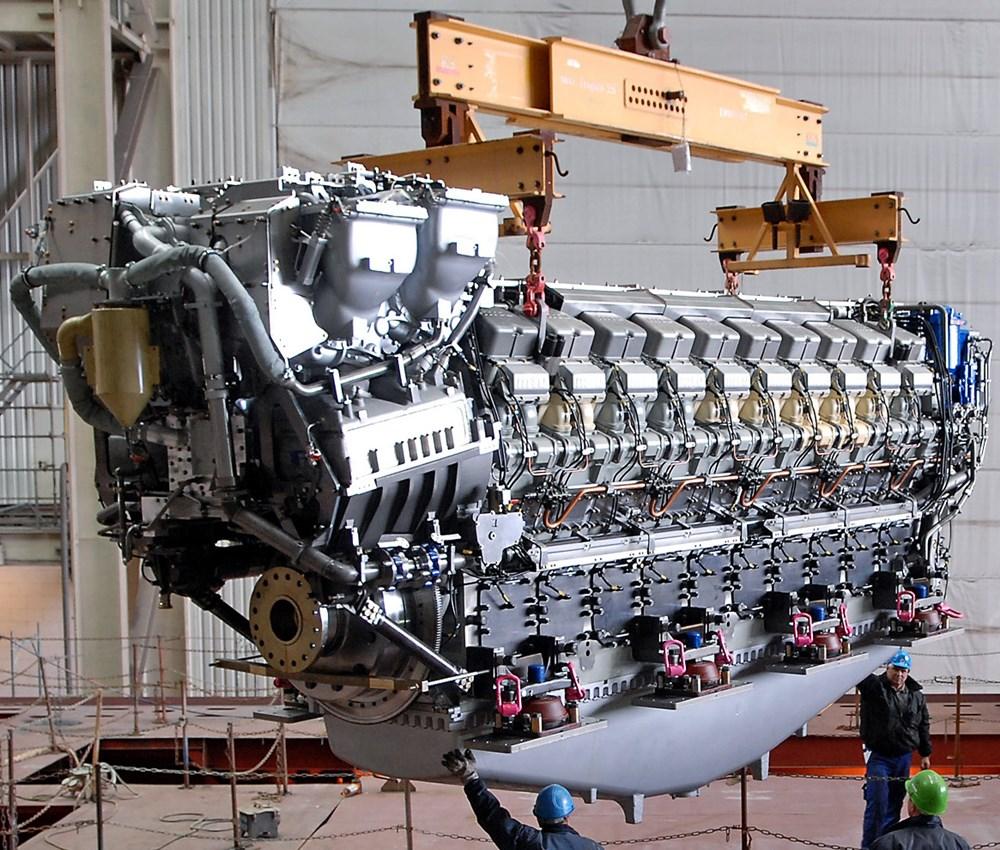
Marine steam engines
The cruise industry began in 1844, when ships were propelled by steam engines, performing the driving of propellers by using steam as working fluid. The largest passenger steamship (before hitting an iceberg on April 14, 1912) was the Titanic, powered by both reciprocating engines and turbines, able to generate 50,000 horsepower (37 megawatts).
Marine diesel engines
Usually, ships are powered by four or five generator sets (medium-speed, 500 revolutions per minute), fueled by diesel and creating 8-10 MW energy each. The power density of marine diesel medium-speed engine is 80 kilowatts per cubic meter. Ships that use diesel engines are required to carry exhaust-treatment systems and catalytic-reduction equipment to reduce the environmental impact.
Marine nuclear power engines
The building of the US first and only merchant nuclear-powered ship was commissioned in the 1950s by President Eisenhower. Of total cost $46.9 million, on the fuel core and nuclear reactor was spent more than $28 million. The ship operated only for five years (1965-1970) but due to the high running costs, its service was terminated.
Marine gas turbines
The first company that fitted cruise vessels with gas turbines, was Royal Caribbean. Gas turbines are greener than diesel engines and allow ships to sail with reduced inventory and smaller maintenance crew. Gas turbines drive generators which in turn provide electricity to propeller motors. They recover heat from gas turbines' exhaust, which then is used to produce the electricity needed for onboard services (air conditioning, water heating).
Rolls Royce is the manufacturer of the world's largest GAS marine turbine "Rolls-Royce MT30". The turbine will provide the immense 109 MW of power for the 2 propellers, all the weaponry, radars, command sys, etc. of the new generation UK aircraft carriers of the Queen Elizabeth class. To this class belong HMS Queen Elizabeth (2017-commissioned) and HMS Prince of Wales (2019-commissioned), each of them with a total power consumption of 80 MW.
Gas-turbine cruise ship power system
The first large vessel to use a new gas-turbine cruise ship propulsion system was Celebrity Millennium . This system will be more frequently used in new cruise ship buildings . It's innovative and, besides new activities available, the economy of scale, marketing, represents an important element of ship design. System's advantages include:
- lower vibrations and noise level, better comfort, lower probability of failure;
- lower exploitation costs because of the easier maintenance;
- nocive emissions reduction, which is partially owed to gas oil instead of fuel (-90% oxide of sulfur, -80% oxide of azote).
- considerable gain of weight and volume, especially when with Azipod marine propulsion system (900 tons, 70 cabins added).
Gas turbines at this time are only interesting in the building of high-speed ships (warships, and especially aircraft carriers, or fast passenger vessels - Millennium max speed is 25kn), because of the better diesel output in lower speeds and higher price of gasoil instead of fuel for diesel engines.
Gas turbine cruise ship propulsion systems are able to avoid pre-heating systems needed for fuel in classic installations (risk of fire!), as they use gasoil, Celebrity's Millenium-class and RCI's Radiance-class use such turbine powerplants. The next photo shows Celebrity's Solstice-class ship propulsion (the 4 aft azipods, and the underwater hull shape).
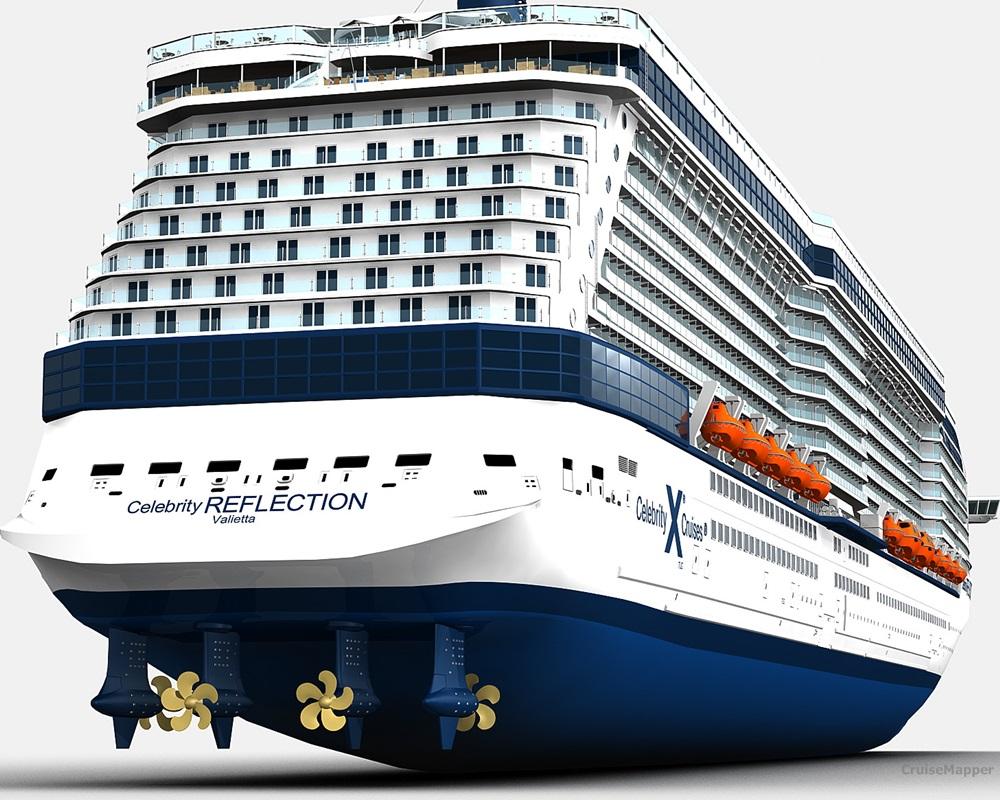
LNG-powered cruise ships
In June 2015, Carnival Corporation announced the company's contract with Fincantieri to build four LNG-powered vessels with the industry's largest passenger capacity. This was part of the order with Meyer Werft and Fincantieri for a total of 9x units to be built in the period 2019-2022.
The four newbuilds became the industry's first LNG (Liquefied Natural Gas) powered vessels using LNG in their hybrid engines. The gas is stored in the ship and used to generate all needed power at sea. The engines are not exclusively LNG, but "dual fuel" (capable of burring both liquid marine fuel and natural gas). This design is for saving onboard space (reducing fuel storage space required).
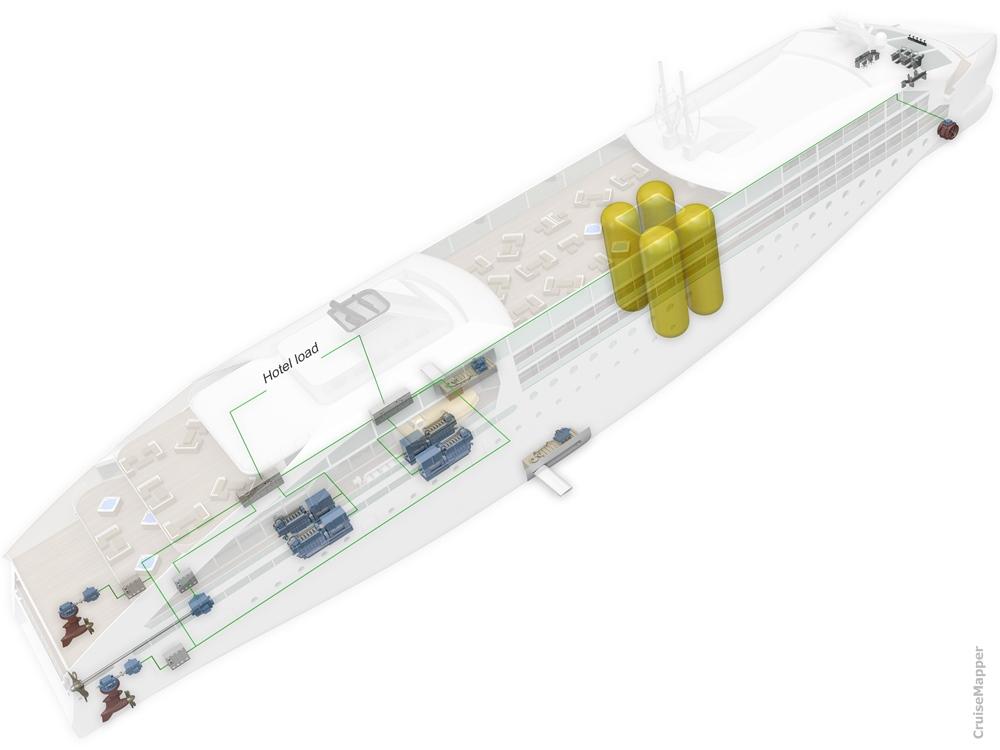
LNG is natural gas, which consists of 90% methane and 10% ethane. When cooled to -160 C, it passes from gas to liquid, and its volume decreases over 600 times, making it very efficient for distribution. Long-distance LNG transportation is via dual-hull gas carriers. Short-distance LNG transportation is via trucks or smaller vessels (also barges) fitted with high-pressure tanks.
Gas fuel eliminates all the bad emissions - soot and sulfur oxides. In April 2016 MSC Cruises announced its contract with STX France for up to four LNG-powered ships with GT over 200,000 tons each. For comparison, the Oasis of the Seas is 225,000 GT tons. The new MSC ships have 5400 passengers capacity at double occupancy each. The first one is scheduled for delivery in 2022. Its power plant will be based on a new prototype engine.
Using LNG to power large cruise ships is a relatively new (2016) concept. Due to LNG tanks' large sizes, this fuel is used usually on smaller passenger shipping vessels ( ferries ) operating on short crossing itineraries. LNG bunkering facilities available in ports are very few. Compared to other fuels (including MGO / marine gas oil), LNG is purer (no unburned residues, fewer greenhouse gases), more efficient, stable and cheaper (reduces fuel costs). LNG technology also advances due to IMO's future maritime emissions regulations, especially in ports and while operating in environmentally sensitive destinations.
In comparison to pipeline gas, LNG is superior in quality - purer, with more methane and other energy content. Its chemical structure also has a stable composition that doesn't generate unburned residues, soot or any particulates. In addition, because the fuel is so clean, on LNG-powered ships maintenance intervals are doubled (over 25,000 hours / ~10140 days), as opposed to the standard MDO-powered 12,500 hours (520 days).
- All the world's major environmental organizations and the marine shipping industry joined for an explicit prohibition on the carriage of non-compliant fuels when the 0,5% sulfur cap takes effect in 2020.
- In January 2018, IMO announced that starting January 1, 2020, the marine fuels' max allowed sulfur content (outside Emission Control Areas) is reduced from the previous 3,5% to 0,5%. Unless marine vessels are using approved equivalent compliance methods, after Jan 2020 there is no reason for ships to use non-compliant diesel fuels.
- IMO's new sulfur cap's goal is to provide substantial health benefits by reducing marine fuels' sulfur content (SOx gases). At the same time, IMO's lowered cap significantly increases ships' operating costs.
The LNG cruise ship concept was first introduced by Wartsila (Finnish manufacturing company) and is based on drive shaft propulsion instead of azipods. The LNG tanks' location is in the upper deck area (right below the funnels). The Rolls Royce concept is based on azipods.
AIDAprima (2016) is one of the world's most technologically advanced cruise vessels. The ship rides on a cushion of air, thus reducing frictions and fuel consumption, The new technology is called MALS ("Mitsubishi Air Lubrication System"), allowing the liner to glide on an air bubbles carpet.
The ship's 4 main engines are dual-fuel (heavy oil and LNG gas oil) thus reducing fuel consumption. The ship has an advanced filtering system that reduces stack emissions (greenhouse gases). The ship's propulsion features 1 pair of stabilizers and 2x ABB-pod drives (new XO-Pod series, power output per unit: is 3 MW). The total power output is 48 MW. AIDAprima is also the world's first-ever "LNG cruise ship" as it uses LNG fuel supply while berthed in ports.
For its LNG-bunkering operations in Florida (at homeports PortMiami and Port Canaveral ), CCL-Carnival partnered with Royal Dutch Shell plc as fuel supplier for the liners Mardi Gras (2021) and Celebration (2022).
AIDA's LNG-powered cruise ships
The AIDAprima ship's first successful test run for LNG supply was in Hamburg Germany on May 7, 2016. While berthed, the ship was successfully provided with LNG at all the itinerary's ports of call (Hamburg, Rotterdam, Le Havre, Southampton, Zeebrugge).
- The company's statistics show that the AIDA ship spends about 40% of its operating time in ports. Compared to using conventional marine diesel (0,1% sulfur content), by using LNG, the vessel's emissions were considerably reduced even further. Sulfur oxides and soot particles were prevented completely (while in port), nitrogen oxide emission was reduced by up to 80%, CO2 emissions were lowered by 20%.
- AIDA ships (produced by Shipyard Papenburg ) are 100% LNG-powered. AIDA invested in research and testing of LNG cruise ship technologies since 2015. In 2013, AIDA collaborated on LNG hybrid barges with Becker Marine Systems. The innovative and flexible solution is used on ships moored in Port Hamburg.
- Since May 30, 2015, AIDAsol is regularly supplied with low-emission LNG power at Hamburg's Hafencity Cruise Terminal.
- AIDA ships use just 3 liters (0,8 US gallons) of fuel on average per person on board for a 100 km (62 ml) trip. This was confirmed by an independent expert study in 2012. Following the implementation of new technologies and economical handling of resources, the company's statistics for 2016 (over 2012) showed reduced energy consumption (9% per person onboard), reduced water consumption (7,2% pp) and reduced CO2 emissions (7,7% pp).
Hurtigruten ships
In April 2018, the Norwegian cruise and ferry company Hurtigruten announced a USD 150 million fleet renovation project. Almost all vessels will be upgraded with new hybrid powerplants that combine LNG-engines and batteries.
For the project was contracted Rolls-Royce Marine, initially for 6 ships plus optional another 3. The program's completion was scheduled before January 1, 2021. The project also includes all vessels to be upgraded with shore power capabilities.
Dual-engine ferries (LNG-MDO)
The next scheme shows the dual-engine powerplant (Wartsila) and propulsion (Azipod) of the cruise ferry Tallink Megastar . This ship is the biggest "floating superstore" on the Baltic Sea, featuring a 2-deck retail shopping complex and the unique self-service option called "Q-shopping". The RoPax vessel uses LNG as prime fuel and MDO (marine diesel oil) as secondary fuel.
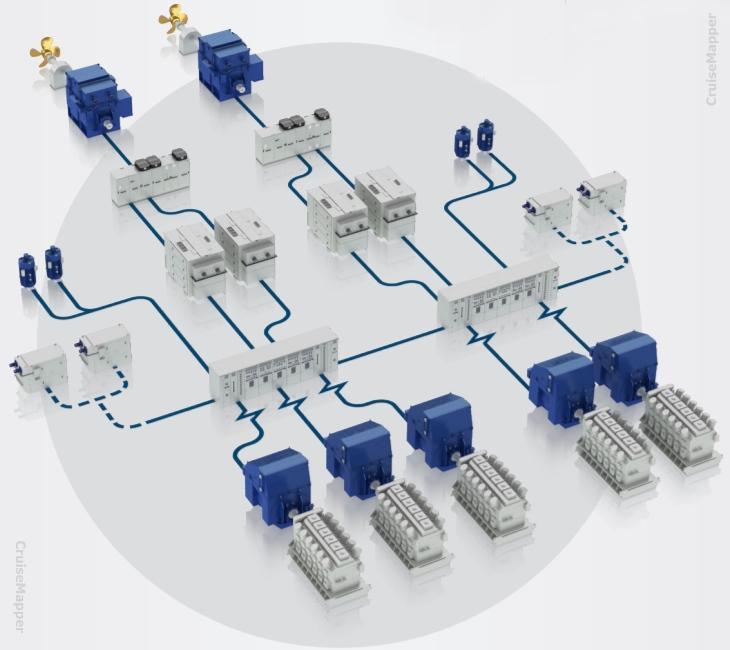
The ship is powered by a total of five Wartsila dual-fuel engines - three 12-cylinder (model 12V50DF, combined output 34,2 MW) plus two 6-cylinder (model 6L50DF, combined output 11,4 MW). Ferryboat's total power output is 45,6 MW. Its propulsion system includes two Wartsila fixed-pitch propellers with twin propeller shafts. Navigation systems are also Wartsila-made, including NACOS Platinum (integrated vessel control system).
The power generated by the main engines/powerplant produces electricity that is used from the propulsion motors, as well as all auxiliary systems and hotel functions. This innovative maritime technology allows the engines to be started and stopped depending on the onboard electricity demand, which additionally improves fuel efficiency.
Vessel's hull is ice-strengthened (class 1A). Rudders are from Becker Marine Systems. When compared to traditional marine engines, in gas mode, the ship's engines produce 1/4 less COx, 2/3 less NOx, zero SOx and no soot particles.
The onboard LNG system consists of 2 bunker stations, 2 horizontal LNG storage tanks by Linde (cryogenic, vacuum-insulated, stainless steel, total gas volume 600 m3), double-walled bunkering lines, pipelines (acid-proof stainless steel), special pipe fittings, gas distribution system, steam boilers. All the ship's electrical equipment is certified "explosion-proof". The LNG is stored at temperatures -160 Celsius (-256 Fahrenheit) and under pressure 4-6 bars.
ABB supplied the vessel's power and electric propulsion systems, as well as the Octopus (smart energy management system). While mechanical propulsion is optimized for a single-speed, electric propulsion is based on rotating speed control resulting in energy efficiency at all speeds. ABB's propulsion also improves passenger comfort as the ship runs much more quietly and smoothly. ABB's Octopus marine technology allows real-time monitoring of the vessel's energy (and fuel) consumption. Based on the collected data, the software suggests optimal performance recommendations.
Spain's first LNG-powered cruiseferry was Hypatia de Alejandria (2019) owned by BALEARIA .
Wind-assisted propulsion
On April 12, 2018, the VIKING LINE -owned ferry Viking Grace became the world's first-ever passenger ship equipped with a rotor sail utilizing wind power. This also made it the world's first hybrid vessel that uses both wind power and dual-fuel (diesel-gas) engines.
"Rotor Sail Solution" is an innovative technology developed by the company Norsepower Ltd (Finland) in 5 years. It reduces fuel consumption and also COx emissions up to 900 tons per year (depending on wind conditions).
The cylindrical rotor sail has a height of 24 m (79 ft) and a diameter of 4 m (13 ft). The technology is based on the "Flettner rotor" (patented by Anton Flettner in 1922) and uses the so-called "Magnus effect" - the spinning rotor (rotating cylinder) drags airflow faster around one side. This creates pressure/speed difference that moves it in the direction of the opposite (lower-pressure) side, creating a force at a right angle to the direction of the wind. This wind-assisted propulsion power drives the ship forward. Unlike traditional cloth sails, the rotor needs no furling (stowing), reefing (reducing sail's area) or line-tending. The rotor sail system is automated and shuts down when unfavorable changes in wind force or direction occur.
Added to the dual-fuel engines, the new technology makes Viking Grace one of the world's most environmentally-friendly passenger ships, operating with very low levels of emissions and noise. Norsepower's wind propulsion system was also installed on VIKING LINE's newest vessel (still unnamed) scheduled for delivery in 2020. The China-built ferryboat is equipped with two Norsepower-produced rotor sails, doubling its wind power potential.
Ship's powerplant includes 4x Wartsila engines (model 8L50DF, total power output 30,4 MW). Propulsion is diesel-electric (2x shafts with fixed-pitch propellers) and wind-assisted (with 1x rotor sail). Engines are dual-fuel (MDO-LNG). As gas tanks are larger than marine fuel tanks. they need 6 times more space. To save hull space, LNG tanks are located on an open deck. LNG tanks are two (type C / vacuum insulated), each with capacity 200 m3 and weight 140 tons (LNG weight 85 tons per tank).
MS Viking Grace is also the world's first ship with the energy recycling system "Ocean Marine" (developed by Climeon AB / Stockholm-based company). The system converts the excess heat (generated by engines and exhausts) into clean (emission-free) electricity with an annual capacity of 700,000 kWh. This electricity is primarily used on cabin decks (including for heating, hot water, lighting). The technology uses heat exchangers that evaporate a carrier fluid circulating in a closed system. This gas (at 2-bar pressure) drives a turbine, then a 100 kW generator produces electricity. After that, the gas is cooled (in a vacuum chamber) and liquefied. Cooling is rapid, as the cold fluid is sprayed out. Then Heat exchangers cool the carrier fluid to temperatures around 20 C / 68 F.
Cruise Ship Fuel Consumption
How much fuel do cruise ships use.
Cruise ship fuel consumption depends on the ship's size. For most vessels, the average consumption is 30-50 miles on a fuel gallon. This will be also determined by other factors using fuel. Ships' gas mileage varies depending on the type and size of ship, the number of passengers on board, and other factors. Larger ships need more fuel to move through the water.
RMS Queen Mary uses 6 tons of marine fuel per hour. Celebrity Eclipse gets 56 feet to the gallon. MS Zuiderdam - .0130 miles per gallon (0.34 tons fuel per mile). This may not seem very good mileage at first glance, however, cruise ships are moving at once thousands of people whereas a car is moving a few.
Nearly all contemporary cruise ships are powered by electricity (motors turn propellers). It powers the air conditioning systems, lights and all other appliances aboard the ship. Most vessels produce the electricity they need by using diesel engines. Some use gas turbine engines. Others use a combination of the two. HFO (heavy fuel oil) is used by diesel engines, while MGO (marine gas oil) is used by gas turbine engines. The MGO is similar to the jet airplanes' fuel.
Speed affects cruise ship fuel consumption because to go faster, vessels must increase the electricity flow to motors. Thus more engines are employed, and it, in turn, increases fuel consumption. For example, Queen Mary 2 consumes 237 tons MGO and 261 tons HFO a day when at full speed. After a certain point, the rate of return decreases from adding engines, because if a ship can manage 17 knots by two engines, it doesn't mean that four engines are going to produce 34 knots.
Cruise companies employ new technologies in order to reduce fuel consumption. Ship's hull, for example, can be applied by silicon coating in order to reduce friction as the ship goes through the water. Friction reduction on Celebrity Eclipse is 5%. Another experiment is LED lighting, using less energy and producing less heat (thus is reduced the demand for electricity and air conditioning). Celebrity Solstice-class vessels have solar panels' field over the AquaSpa pool area. This not only provides shade for the pool area but produced by solar panels electricity is used to decrease the electricity demand from the engines.
RMS Queen Mary 2 is equipped with exhaust gas economizers, using waste heat from engines to produce steam. Then steam is used to heat fuel and QM2 hotel accommodations, laundry, galleys. This reduces the energy amount that has to be produced by ship's engines. The Promas Lite system (mentioned above) generates cruise ship fuel savings in the range of 5-15% depending on the operation type and the actual performance of the ship's existing propeller.
How marine ships fuel consumption increases at higher speeds? Next infographic shows the speed-fuel consumption relation on container ships (their sizes are measured in TEU-containers/20 ft equivalent units), which are similar by speeds and even gross tonnage to cruise passenger ships.
Cruise Ship Pollution
Today cruising is one of the most popular vacations, but there are significant environmental downsides. Mega-ships burn the dirtiest fuel in the world, even if they are sitting in port. Asthma, cancer, respiratory illness, heart disease, are the results of burned in ports nasty bunker fuel.
Shore-to-Ship Power Supply
Those who support the cruise industry point out that cruising has never been more popular. However, more ships generate more pollution. A solution is to have docked vessels plug into the port's shore power grid. Most of the world's largest cruise ports have such dockside electrical hookups, reducing bad emissions by up to 95%.
Aka "cold ironing" and "shore-to-ship power", shore power capability allows berthed cruise ships to shut down their diesel engines (main and auxiliary) and plug into city's electrical grid, using locally-produced electricity for all shipboard equipment and services - including cooling, heating, lighting, emergency, etc. The technology greatly reduces exhaust emissions in seaports. Next video animation reviews this technology.
TUI Cruises Ships Environmental Report
TUI published the company's environmental impact report (first of its kind) including environmental objectives and TUI strategy for a 5-years period. TUI said it planned to issue reports every 2 years. According to it, in 2012 TUI reduced by 3.7% per nautical mile its fuel consumption, and expects further 5% reduction, reducing CO2 emission at the same time by 0.5 kg to 0.55 kg per traveler.
Energy efficiencies are the key to reduce fuel consumption, CO2, and other emissions, and contribute to climate protection. Mein Schiff 3, for example, is expected to feature special energy management systems that help to consume 30% less energy than comparable size ships. TUI is focused on reducing recycling and waste, too. In 2012, TUI reduced the waste amount to 10,7 L (per passenger day), which is 27,8% less (over 2011). In 2012, TUI used 54,463 tons of fuel, including 9,732 tons LSFO (low sulfur fuel oil), 40,880 tons HFO (heavy fuel oil) and 3,851 tons MDO (marine diesel oil). Fuel consumption was 0,367 tons per nautical mile.
All new TUI ships are built to the latest standards with environmentally-friendly marine technologies. These vessels, both as design (hull and superstructure) and implemented technologies, are highly energy-efficient. Each consumes 1/3 less energy compared to most cruise liners. The advanced exhaust cleaning system uses a catalytic and scrubber converter. This technology allows sulfur emissions to be reduced by 99%, and NOx emissions - by 75%.
All-electric passenger ships
In May 2019, the US company "Maid of the Mist" ordered ABB two new all-electric vessels for the company's Niagara Falls tours. Both catamarans are 100% emission-free being powered by high-capacity batteries. Each ship is fitted with two battery packs (combined capacity 316 kWh / 563 HP output). The electricity is provided by 2 fully-independent power systems and split evenly between the 2 hulls.
Shoreside battery charging takes just 7 min (per ship). The powerplant is controlled by ABB's PEMS (Power and Energy Management System), which also optimizes the onboard energy use. Ships' batteries are charged using hydropower (water-generated electricity), which as of 2019 accounts for ~7% of the USA's total electricity production. In addition to the shoreside charging connection, ABB supplied the newbuilds with switchboards, motors, integrated control systems and ABB Ability's Marine Remote Diagnostic System (24-hour equipment monitoring and predictive maintenance).
Battery power is used during turnaround navigation in ports when the onboard diesel-electric generators are switched off. For ferry batteries (fabrication, delivery, and installation) is often contracted the Canadian company Corvus Energy (Richmond BC) - one of the world's largest manufacturers and suppliers of energy storage solutions (ESS) for the maritime industry. The company provides ESS to hybrid and all-electric ferries. As of 2019, Corvus Energy delivered its innovative product line "Orca ESS" to 200+ vessel conversion/upgrade projects, totaling 200+ MWh.
At the following tag-link can be found listed all CruiseMapper's news related to propulsion-power accidents .
This cruise vessel technology-related survey is integrated with our articles on passenger ships building and safety , and the statistical ones about registry/flag-states , cost to build , speed , passenger capacity . All ship links redirect to the vessel's "itinerary-schedule-current position" page.

How Much Fuel Does a Cruise Ship Use?
Cruise ships are the biggest and mightiest sea-going vessels available in the shipping industry at present. Unlike the cargo ships, these carry passengers for entertainment and transport across the water bodies. Hence, the common question of how much fuel does a cruise ship use arises often.
The primary requirement of these cruise vessels is passenger safety and engagement. In such conditions, their maintenance stoppages will be minimum and with high safety awareness.
Moreover, the tightening of regulation under Annex VI of MARPOL and IMO guidelines monitor these ships regularly. Any extra emissions can get them in trouble as they tour some of the most sensitive tourist destinations.
The size difference of these sailing giants also decides their fuel utility and efficiency. The biggest cruise ship at 360 meters long consumes almost double the fuel of an average vessel. Hence, fuel quality, grade, and engine efficiency are important for knowing how much fuel does a cruise ship use.
In the article, we discuss the consumption figures of these modern luxury sailing hotels. Moreover, we also consider the changes in the propulsion technology affecting fuel consumption and storage.
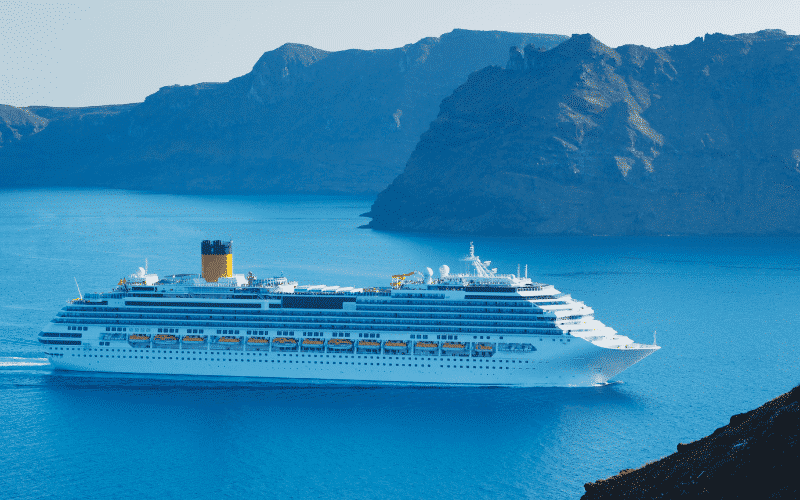
Factors Deciding the Fuel Consumption of Cruise Ships
A ship’s fuel consumption depends on several factors varying from its structure to carriage capacity. Meanwhile, cruise liners have only one cargo, with the highest value amongst all, the human life! To approximate an ideal fuel consumption outline, the crew accounts for several changes.
Vessel Route
Cruise vessels mostly dwell around the coastal areas with occasional visits to the deep ocean. A major reason for this is that passengers want to indulge in the onboard and shore enjoyment together. Hence, once the vessel route comes through, the bunker estimations go underway.
This will include the port stays, sailing conditions, and carriage capacity too. If the engine department has information of rough weather, the same is taken into account for surplus bunkers.
Engine Generation and Consumption Characteristics
It becomes important for the crew onboard to know the engine characteristics. For example, a third-generation engine and its performance between eco speed to full load vary considerably. This means every engine will have a unique consumption chart depending on these characteristics.
Makers such as MAN B&W, Sulzer, Mitsubishi, etc. include these curves within their manuals. Since the cruise ships follow similar patterns of sailing without load variation, the calculations are steady.
Sailing Speed
Modern cruise vessels hit speeds of 22 to 24.5 knots during their international voyages regularly. This means their operation in the range of 85% load and above is quite frequent too. Under such conditions, the consumption increases more than 40% of the eco speed performance.
Meanwhile, sailing on the coastal edges mostly uses eco or low-speed movement. This means a balance of speed variation limits the excessive burning of fuel. It also makes sure the vessel complies with the emission regulations within the region.
Load Parameters
The cruise ship draughts have a lesser variation in comparison to the cargo ships available. Hence, the load parameters do not necessarily depend on it but rather the weather conditions. With a relatively higher draught, the propeller performance varies significantly with the changing sea conditions.
This means the load parameter of the cruise ship will rather be a dynamic factor than static. Most owners always provide their ships with surplus bunkers for safe navigation under such conditions.
Ship Size and Construction
The size and construction parameters of the ship are static factors for its lifetime. These considerations are always present in the accounting of the engine performance too.
It means that a steady correction factor is available for the consumption chart concerning these points. Therefore, correcting the bunker figures with these coefficients will give the correct bunker values.
Propulsion Types and their Fuels for Cruise Ships
After considering the design and performance factors, the nature of propulsion is the next big step. The changing propulsion design and source decide how much fuel does a cruise ship use.
Conventional Diesel Propulsion
After the arrival of 0.5%, sulfur content regulation under MARPOL, diesel engines faces significant changes. The big reason for this change is the change in specific gravity of the fuel under usage in the engine.
Consumption of Fuel (Metric Tons) = Consumption of Fuel (meter cube) X Specific Gravity of the fuel
The blended oils and the VLSFO fuel have significantly less density, making its volume go higher. Hence, the bunkering team takes consideration of the same while fueling estimations.
The traditional cruise ships rely heavily on diesel (less than 0.1% sulfur) for their propulsion. The power system on board, including the generators and the boilers, also operate on this fuel.
Electric Propulsion
In the electric propulsion systems, the main engine does not utilize any driving fuel. This lowers the consumption significantly in comparison to the standard diesel propulsion. The big sets of alternators produce the power that is useful to drive heavyweight electric motors.
Most electric propulsion cruise ships have a twin-screw or triple-screw propeller design . Hence, a reduction in load uses the propeller ability accordingly.
Shaft generators are also useful in lowering the consumption with the production of electrical power. This removes the auxiliary machinery out of the picture while sailing, reducing the fuel consumption.
LNG Engines
To eliminate the demerits of diesel fuel, modern cruise ships are using LNG propulsion. The storage of LNG and its usage parameters differ from that of any other available fuels. Its higher calorific value also has a great effect on the fuel efficiency of the engines.
However, the LNG compatible ships have a trademark LNG engine onboard. Cruises with standard engines can’t burn this fuel for propulsion power. In addition, the refrigeration system and inert gas regulation change considerably with LNG as a bunker.
Consumption Figures for Cruise Ships
After considering all these factors, it is easier to understand how much fuel a cruise ship uses. While the individual ships differ on their size and design, generic figures will help you out.
Large Size Cruise Vessels
With all the above considerations, cruise ships over 300 meters in size consume 200+ MT of fuel. The figures at 85% and above load go as high as 235 to 250 MT of fuel per day. It includes the power generation system for the generators available onboard. The boilers firing for steam generation also use the same grade of fuel. However, 80% of the fuel and more goes mainly into the propulsion of the ship.
The fuel consumption for such ships reduced to 150MT when operating in the eco speed range. Moreover, it goes down further when the vessel is manoeuvring near the visiting ports.
On average, these vessels go from 7.5 MT to 20 MT during the port stays. The significant difference also includes the passenger behaviour of visiting the shores, resulting in lower power usage.
Moderate Size Cruise Vessels
For cruises varying between 150 to 250 meters, the fuel usage goes down fast. This takes into account their short voyages as well as shorter port stays. These typical sizes range between 140 to 180 MT of their 85% and above rated loads of fuel consumption.
Hence, these vessels can give you speeds of 20 knots and more with such consumption. Meanwhile, like their larger sisters, the medium-size cruises also have manoeuvring requirements. Under such conditions, the fuel usage is lesser as well.
The consumptions drop to an average of 120 to 135 MT per day for loads between 60 to 85%. Moreover, the figure also goes below 100 MT if the vessel has a near-port drifting schedule.
Smaller Passenger Vessels
The declining trend continues for the passenger capacity and the size of cruises. It reflects in the fact that smaller passenger carriers typically use 100 to 120 MT of fuel.
The figures do not ascertain a consumption guarantee but reflect the observation trends. These trends include the calculation of Specific Fuel Oil Consumption for Power requirements. The highest consumptions go in the maintenance of 5- and 7-star facilities onboard for the passengers.
Specific Consumption for Energy Generation
The specific consumption of fuel for power generation at the European cruise terminals is available. It shows the fuel consumption per hour and the KW requirement for the port operations. These figures vary significantly at sea where all entertainment sources are driven by shipboard power.

Comparisons With Cargo Ships
Cruise ships consume a lot more fuel in comparison to the average cargo vessel. However, this stands as an exception to the large container ships that also have higher consumption limits. Therefore, this needs one to understand how much fuel a cruise ship uses and why it is relatively high.
Nature of Profit
Cruise Ships rely on passenger pleasure for their profit and turnover. Hence, the power requirements onboard ships are extremely high and diverse in usage. This needs multiple auxiliary engines and power systems for the upkeep.
The consumptions are even higher than a standard 5-star hotel on land. Hence, the power generation fuel requirements onboard cruises are almost 10 times a standard bulk carrier. This also includes auxiliary services like steam generation and boiler operations.
A traditional tanker or bulk carrier has long-distance voyages with steady speed. These values range between 12 to 14 knots, with delivery dates and design considerations being important.
The same does not stand true for cruises and container ships, where speed is of paramount importance. These beasts move as fast as 24 to 26 knots at a given time. With such high speed, the specific fuel oil consumption goes way over the bar.
It also means a large amount of energy is important to maintain these speed and power requirements. Hence, the fuel consumption almost quadruples itself than a standard bulk vessel.
Fuel Storage on Cruise Ships
Cruise Ships rely heavily on their external appearance to attract more people towards them. This restricts the fuel storage options for the crew on board the ship and its monitoring too. These factors also account for the safety of the passengers under operating conditions.
Bottom Tanks
The cruise ships have a bottom-heavy design when it comes to bulk fuel storage. However, the tanks are not cumulative but distributive across the length. This accounts for the dynamic stability and also uses less space for higher passenger capacity.
Remote Monitoring
Monitoring of fuel levels across all tanks is important for these ships for regular updates. In addition, the hectic nature of work and safety aspects need mandatory remote gauges on each tank. All these gauges direct back the readings to the control room for the engine crew monitoring ability.
Settling and Service Tanks
Very rare do cruise ships rely on the fuel of lower quality for power generation. This means the purpose of the settling tank is to mostly separate water (if any) from the standard diesel fuel. The general bunkers for cruise vessels are high-quality and expensive to adhere to the coastal regulations.
The service tanks provide a direct inlet to the propulsion engine or generator engine. The supply system has fine filters, temperature regulating elements, and other fine instruments.
Bunkering Safety
Since bunkering mostly proceeds before the voyage or during port visits, safety remains important. Moreover, the nature of cruise ships makes them even more aware of the possible hazards. The LNG bunker uses the standard coupling at the selective terminals available globally.
Cruise Ship Fuel Usage
With such changing fuel consumption patterns, cruise ships use a high share of fuel in shipping. The changing regulations are also dictating the adaptability of these ships to use electric propulsion. Modern vessels also use dual propulsion, using both electric and fuel resources.
However, the changing market is shifting fast towards the LNG sources for propulsion. Therefore, the vast spread of terminals for LNG refuelling will considerably reduce these figures for the cruise liners.
The use of LNG will drastically change the question of how much fuel does a cruise ship use. It reduces the specific consumption figures for power generation at sea from 0.30 to 0.15 kg/kWh. Hence, the evolving fuel option produces a cleaner and cost-efficient alternative to the cruise industry.
You might also like to read:
- How Are Cruise Ships Powered?
- Titanic vs Modern Cruise Ship: How Ships Have Evolved
- How Do Cruise Ships Get Fresh Water?
- Engineering Department Onboard Cruise Ships: A Detailed Guide
- Video: Why Are Cruise Ships White?
Disclaimer : The information contained in this website is for general information purposes only. While we endeavour to keep the information up to date and correct, we make no representations or warranties of any kind, express or implied, about the completeness, accuracy, reliability, suitability or availability with respect to the website or the information, products, services, or related graphics contained on the website for any purpose. Any reliance you place on such information is therefore strictly at your own risk.
In no event will we be liable for any loss or damage including without limitation, indirect or consequential loss or damage, or any loss or damage whatsoever arising from loss of data or profits arising out of, or in connection with, the use of this website.
Do you have info to share with us ? Suggest a correction
Related Articles

The National Maritime Centre: Providing Quality with Utility
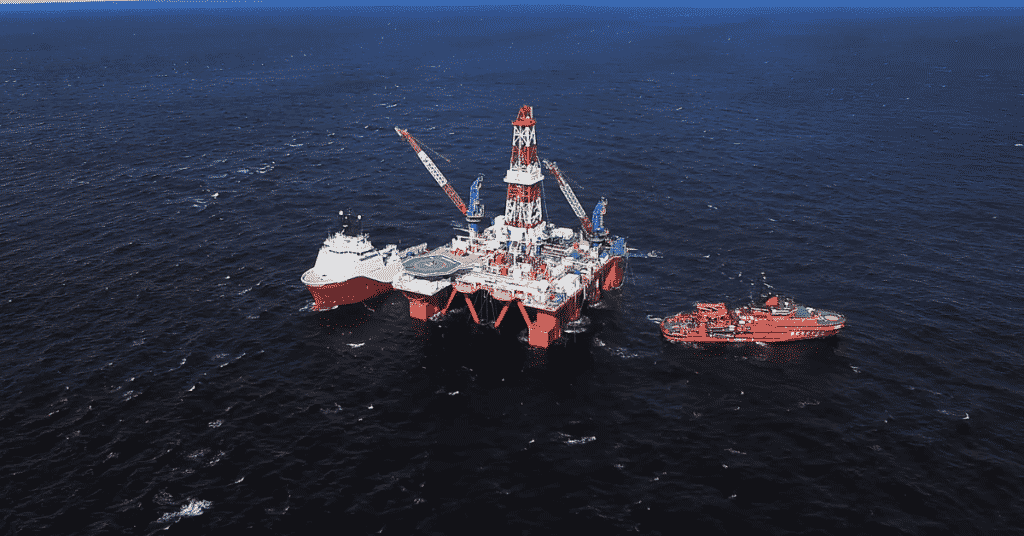
Subsea Drilling: The What, Why and How
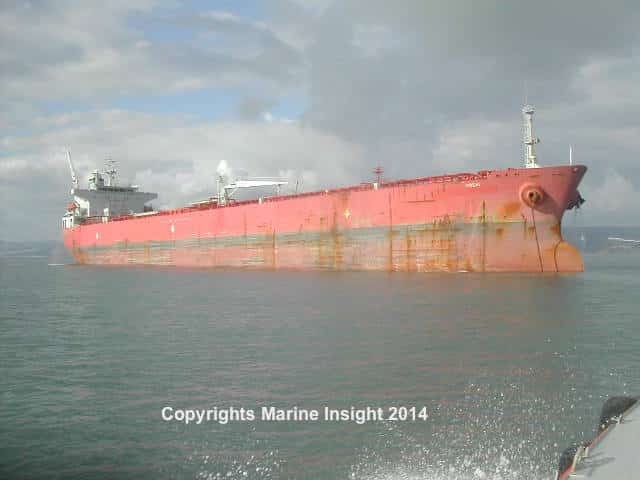
The Institute of Chartered Shipbrokers (ICS) Exams and What they Mean to an Average Shippy

About Author
Saurabh Sinha is an active marine engineer, sailing with one of the leading shipping companies across the globe. A keen interest in exploring beautiful destinations across the globe and immortalising them in words motivates him for professional writing ventures. He values connecting with the readers and sharing his personal experiences.
Read More Articles By This Author >
Daily Maritime News, Straight To Your Inbox
Sign Up To Get Daily Newsletters
Join over 60k+ people who read our daily newsletters
By subscribing, you agree to our Privacy Policy and may receive occasional deal communications; you can unsubscribe anytime.

BE THE FIRST TO COMMENT
Leave a reply.
Your email address will not be published. Required fields are marked *
Subscribe to Marine Insight Daily Newsletter
" * " indicates required fields
Marine Engineering
Marine Engine Air Compressor Marine Boiler Oily Water Separator Marine Electrical Ship Generator Ship Stabilizer
Nautical Science
Mooring Bridge Watchkeeping Ship Manoeuvring Nautical Charts Anchoring Nautical Equipment Shipboard Guidelines
Explore
Free Maritime eBooks Premium Maritime eBooks Marine Safety Financial Planning Marine Careers Maritime Law Ship Dry Dock
Shipping News Maritime Reports Videos Maritime Piracy Offshore Safety Of Life At Sea (SOLAS) MARPOL
WAIT! Did You Download 13 FREE Maritime eBooks?
Sign-up and download instantly!
We respect your privacy and take protecting it very seriously. No spam!
WAIT! Did You Download 12 FREE Maritime eBooks?

Cruise FAQs
How much fuel does a cruise ship use.
Table of Contents
Key Takeaways
- Ship size, power requirements, speed, and itinerary all contribute to the fuel consumption of cruise ships.
- Fuel consumption has significant environmental impacts, including air pollution, greenhouse gas emissions, and the risk of oil spills and improper waste disposal.
- Fuel costs are a major expense for cruise ship operators, and measures to improve fuel efficiency can help reduce operating costs.
- Alternative fuels and technologies, such as liquefied natural gas and renewable energy sources, are being explored to reduce fuel consumption and minimize environmental impact.
The Basics of Cruise Ship Fuel Consumption
Factors affecting fuel consumption, ship size and capacity, speed and itinerary, fuel efficiency measures, environmental impact of cruise ship fuel consumption, air pollution, greenhouse gas emissions, oil spills and water pollution, comparison to other modes of transportation, fuel types used in cruise ships, heavy fuel oil, liquefied natural gas (lng), marine diesel oil (mdo), innovations and initiatives for fuel efficiency, regulatory measures for fuel consumption, economic implications of cruise ship fuel consumption, future trends in cruise ship fuel consumption, conclusion: balancing luxury and sustainability in the cruise industry.
- Reduction in greenhouse gas emissions
- Preservation of marine life and ecosystems
- Contribution to a cleaner and healthier planet
- Cost savings in fuel consumption
- Enhanced reputation and customer loyalty
- Opening up new markets and business opportunities
- Promoting a positive image for the cruise industry
- Ensuring a sustainable future for generations to come
- Demonstrating leadership in environmental stewardship
Frequently Asked Questions
What are the average fuel consumption rates of different types of cruise ships, how does the size of a cruise ship affect its fuel consumption, are there any alternative fuels being used in the cruise industry to reduce environmental impact, how do weather conditions, such as wind and currents, affect a cruise ship’s fuel consumption, what are some of the most promising innovations or initiatives in fuel efficiency for cruise ships, is diesel the main source of fuel for cruise ships.

Meet Asra, a talented and adventurous writer who infuses her passion for exploration into every word she writes. Asra’s love for storytelling and her insatiable curiosity about the world make her an invaluable asset to the Voyager Info team.
From a young age, Asra was drawn to the power of words and their ability to transport readers to far-off lands and magical realms. Her fascination with travel and cultures from around the globe fueled her desire to become a travel writer, and she set out on a journey to turn her dreams into reality.
How Old Do You Have To Be To Go On A Cruise
How Much Luggage Can You Take On A Cruise

Meet Asra, a talented and adventurous writer who infuses her passion for exploration into every word she writes. Asra’s love for storytelling and her insatiable curiosity about the world make her an invaluable asset to the Voyager Info team. From a young age, Asra was drawn to the power of words and their ability to transport readers to far-off lands and magical realms. Her fascination with travel and cultures from around the globe fueled her desire to become a travel writer, and she set out on a journey to turn her dreams into reality.

You may like
What culinary delights await on regent's new seven seas explorer?.
Lavish your taste buds with unparalleled culinary experiences on Regent's Seven Seas Explorer, where a hidden gem awaits to tantalize your senses.
Embark on a culinary journey like no other aboard Regent's Seven Seas Explorer, where a world of flavors awaits your palate. From the opulent Compass Rose to the exotic dishes at Pacific Rim, each dining venue offers a unique experience.
But what sets this ship's gastronomic offerings apart? Stay tuned to discover the hidden gem that promises to elevate your dining experience to new heights.
- Indulge in gourmet French cuisine at Chartreuse with classic dishes and impeccable service.
- Experience sushi and seafood delights at Pacific Rim with standout sushi and creative offerings.
- Enjoy diverse flavors at Compass Rose and Prime 7, offering whole Maine lobster and USDA prime steaks.
- Satisfy cravings with indulgent desserts like Chocolate Soufflé and Tiramisu on Seven Seas Explorer.
Dining Options on Seven Seas Explorer
Indulge in a symphony of exquisite flavors and culinary mastery as we explore the diverse dining options awaiting guests on board the Seven Seas Explorer. From the opulent Compass Rose offering a varied menu featuring whole Dover sole and complimentary sauces to the luxurious Prime 7 known for its luscious whole Maine lobster and USDA prime steaks, there's a plethora of dining options to tantalize your taste buds. Sette Mari at La Veranda adds an Italian flair to the mix, completing the array of culinary delights on board.
The executive chef ensures that each specialty restaurant, like the elegant Chartreuse and the flavorful Pacific Rim, offers a unique dining experience. Guests can savor specialties such as pork and shrimp Shui Mai at Pacific Rim or indulge in classic French dishes with a modern twist at Chartreuse. Additionally, the ship offers delightful experiences like Champagne and Caviar under the stars and elegant Afternoon Tea, making dining on the Seven Seas Explorer an unforgettable journey of culinary exploration.
Gourmet French Cuisine Experience
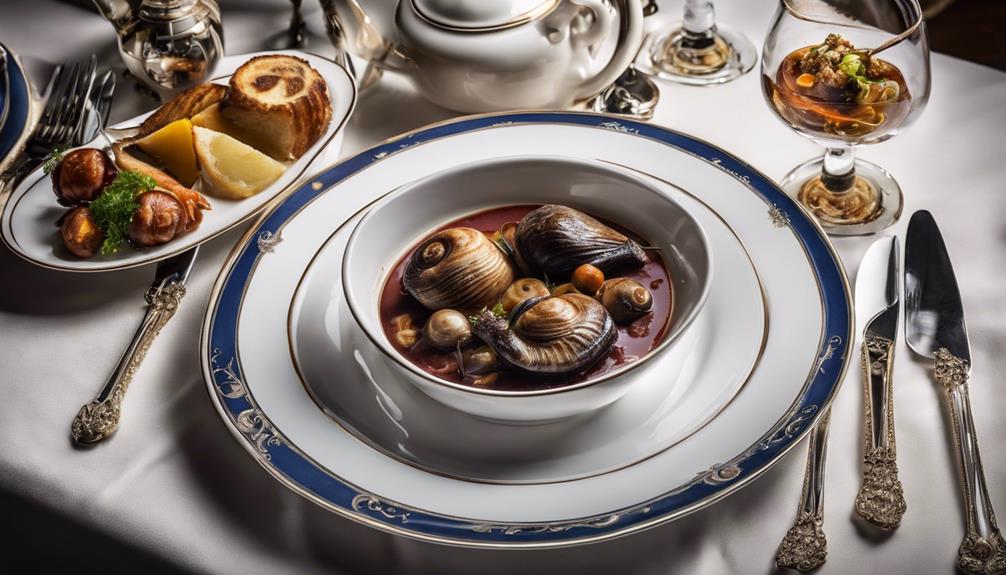
Enhancing the dining experience on Regent's Seven Seas Explorer, Chartreuse offers a luxurious setting and a classic French menu with a modern twist. The Parisian-style ambiance of Chartreuse transports diners to the heart of France, where opulent decor and elegant place settings set the stage for a truly exquisite culinary journey. From the Emmental cheese soufflé to the delicate escargots, each dish at Chartreuse is a masterpiece of traditional French cuisine reimagined with a sophisticated flair.
Here are four reasons why Chartreuse stands out as a gourmet French dining experience on the Seven Seas Explorer:
- Gourmet Delights : Indulge in a menu filled with classic French dishes prepared with a modern touch.
- Luxurious Atmosphere : Immerse yourself in a Parisian oasis with impeccable service and lavish surroundings.
- Exquisite Presentation : Each plate is a work of art, showcasing the chef's dedication to culinary perfection.
- Sophisticated Experience : From the first bite to the last sip, Chartreuse offers a refined dining experience that's truly unforgettable.
Sushi and Seafood Delights
Chartreuse's exquisite French culinary experience transitions seamlessly to the Pacific Rim on Seven Seas Explorer, where sushi and seafood delights await in a Zen-like setting with a focus on creative Pan-Asian dishes.
At Pacific Rim, guests are treated to standout sushi dishes like the delicate Hamachi sashimi and crispy lobster tempura that tantalize the taste buds with their freshness and flavors. Seafood enthusiasts can indulge in delectable options such as the succulent Korean-style barbecue lamb chops, a true fusion of flavors that will leave you craving more.
The ambiance at Pacific Rim is as captivating as the cuisine, with its Zen-like setting and attentive all-female wait staff ensuring a serene dining experience.
The culinary journey continues with creative sushi offerings like the unique open-top pork and shrimp Shui Mai, adding a playful twist to traditional sushi choices. Whether you're a sushi aficionado or a seafood lover, the Pan-Asian delights at Pacific Rim promise a dining experience like no other on Seven Seas Explorer.
Indulgent Desserts to Satisfy Cravings
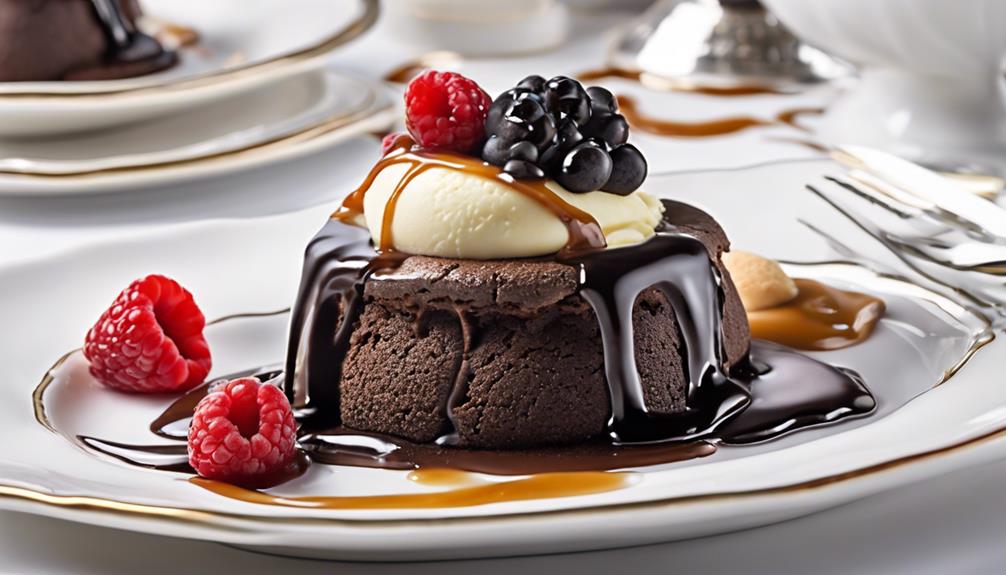
In the realm of decadence and luxury aboard the Seven Seas Explorer, one can find a symphony of indulgent desserts crafted to satisfy even the most discerning sweet tooth. Here are four exquisite dessert options that are sure to tantalize your taste buds:
- Decadent Chocolate Soufflé : Indulge in the rich and velvety chocolate soufflé served with a luscious warm chocolate sauce. The perfect balance of light and decadent flavors will leave you craving for more.
- Classic Crème Brûlée : Delight in the creamy texture of the crème brûlée, topped with a perfectly caramelized sugar crust. The contrast between the crunchy sugar and smooth custard makes every bite a luxurious experience.
- Rich New York Cheesecake : Treat yourself to a slice of New York cheesecake, featuring a creamy and dense texture complemented by the sweetness of fresh berries on top. It's a timeless dessert that exudes elegance.
- Traditional Tiramisu : Savor the layers of espresso-soaked ladyfingers and luscious mascarpone cheese in this classic tiramisu. The perfect balance of coffee, cream, and sweetness makes it a heavenly finale to any meal.
Diverse Flavors for Every Palate
With a plethora of culinary offerings spanning from elegant French cuisine to Pan-Asian delicacies, the Seven Seas Explorer ensures a diverse array of flavors to cater to every palate onboard. Guests can revel in the luscious meals at Prime 7, savoring delights like whole Maine lobster and USDA prime steaks in a luxurious setting.
The Pacific Rim restaurant beckons with a sophisticated ambiance, serving standout dishes such as pork and shrimp Shui Mai and lobster tempura that tantalize the taste buds. For those craving classic French fare with a modern twist, Chartreuse offers delicacies like Emmental cheese soufflé and escargots in a Parisian-style setting that exudes opulence.
Meanwhile, Compass Rose invites diners to indulge in a rich culinary experience with diverse menu options like whole Dover sole, steaks, and chops, all within an elegant ambiance adorned with aquamarine light fixtures and Versace place settings. The Seven Seas Explorer truly caters to a variety of tastes in a setting of pure culinary delight.
What Is Promised to the Guests of Regent Seven Seas Cruises on Every Voyage?
On every voyage with Regent Seven Seas Cruises, we are promised free unlimited shore excursions. Gourmet Explorer Tours and hands-on culinary experiences are offered onboard. Exclusive savings and perks accompany the 32-night Hong Kong to Sydney journey on the Seven Seas Explorer.
What Does Guaranteed Mean on Regent Seven Seas Cruises?
When we book a guaranteed stateroom on Regent Seven Seas Cruises, we secure our chosen category or higher. This promise ensures flexibility and potential upgrades, enhancing our cruise experience with the best available accommodations, adding a touch of luxury to our journey.
What Is Regent Seven Seas Cruises Known For?
We are known for offering inclusive luxury cruises with top-tier culinary experiences. Our commitment to providing unforgettable dining experiences sets us apart. Impeccable service, diverse menus, and gourmet dining venues like Compass Rose, Pacific Rim, and Prime 7 await guests.
Are Drinks Included on Seven Seas Explorer?
Absolutely, drinks are included on Seven Seas Explorer. A vast array of complimentary beverages like fine wines, premium spirits, and specialty coffees are at our disposal. Indulge in top-shelf drinks without extra charges, from champagne to signature cocktails.
So there you have it, folks! The Seven Seas Explorer will take your taste buds on a luxurious journey through the seas of flavor.
With dining options that will make your mouth water and desserts that will satisfy even the sweetest tooth, this ship is a foodie's paradise.
Bon appétit and happy cruising!

Claire, a creative soul with an unquenchable thirst for storytelling, is an integral part of the Voyager Info team. As a dedicated writer, she weaves captivating narratives that transport readers to enchanting cruise destinations and beyond.
Claire’s love affair with writing began at an early age when she discovered the magic of words and their ability to craft worlds and emotions. Her innate curiosity led her to explore various literary genres, but it was travel writing that truly captured her heart. Drawing inspiration from her own globetrotting adventures and encounters with diverse cultures, Claire embarked on a journey to become a travel writer par excellence.
Discover Quito's Rich Heritage and Experiences: A How-to Guide
Mysterious and alluring, Quito's heritage beckons exploration – uncover the secrets that make this city a cultural gem.
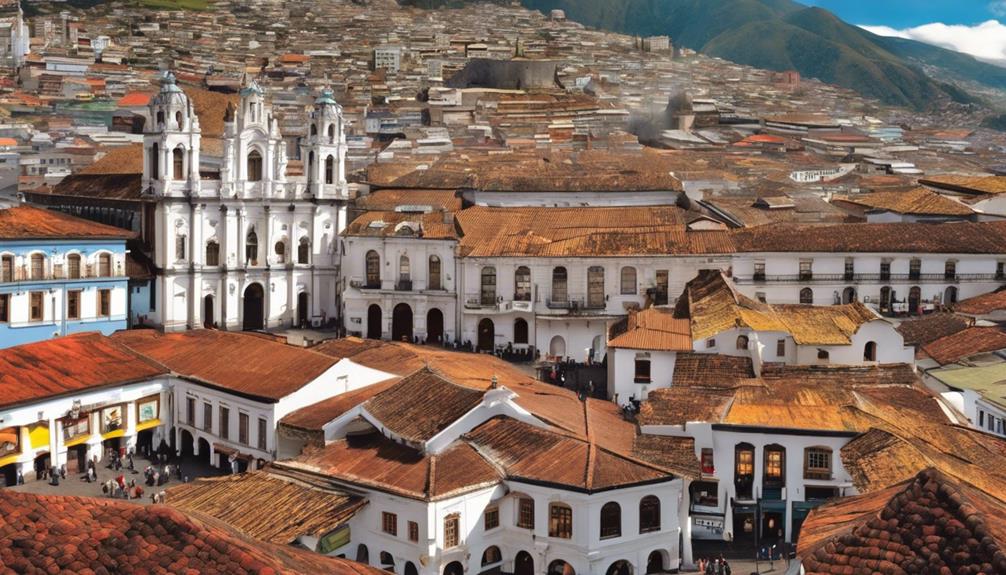
Have you ever wondered what makes Quito's heritage so unique and captivating?
The answer lies in the city's blend of history, culture, and traditions that have stood the test of time.
From ancient civilizations to colonial influences, Quito holds a treasure trove of experiences waiting to be uncovered.
But what sets Quito apart from other destinations?
Let's explore the intricacies of this vibrant city and uncover the secrets that make it a must-visit for any cultural enthusiast.
- Explore Quito's cultural heritage through indigenous art and modern expressions.
- Indulge in Ecuadorian gastronomy blending traditional flavors with cultural influences.
- Enrich your visit with guided tours revealing Quito's diverse history and treasures.
- Immerse yourself in Quito's historic landmarks for a journey through vibrant stories and architecture.
Exploring Quito's Cultural Heritage
In exploring Quito's Cultural Heritage, we immerse ourselves in a vibrant tapestry woven from indigenous traditions, Spanish colonial influences, and modern expressions. Quito's rich cultural heritage is deeply rooted in its indigenous traditions, which are evident in the Andean customs that have been preserved over centuries. The city's connection to its past is brought to life through the skilled craftsmanship of indigenous artisans who create intricate textiles, pottery, and jewelry. These traditional craftworks not only showcase the unique identity of Quito but also play a crucial role in preserving Ecuador's artistic legacy.
The blend of Spanish colonial influences adds another layer to Quito's cultural tapestry, with architecture, art, and traditions reflecting the city's colonial past. Modern expressions further enrich this heritage, creating a dynamic and evolving cultural landscape in Quito. By appreciating and supporting the work of indigenous artisans and embracing the diverse influences that have shaped the city, we contribute to the continuation and celebration of Quito's cultural heritage.
Indulging in Gastronomic Delights
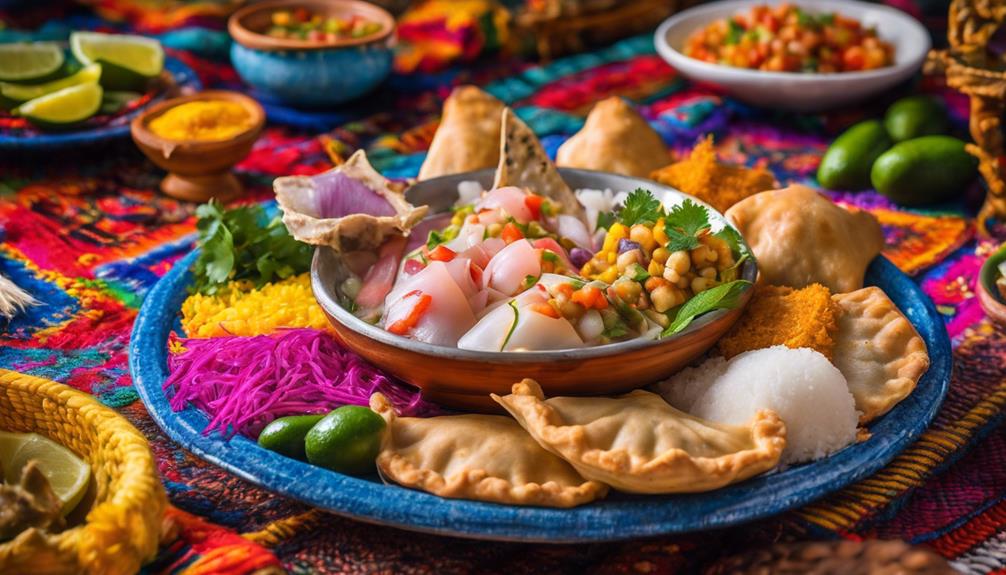
Embark on a culinary exploration through Quito's diverse gastronomic landscape, where traditional delicacies intertwine with modern influences to create a sensory feast. Quito's culinary scene is a vibrant tapestry of Ecuadorian cuisine, offering a plethora of traditional dishes such as ceviche, locro de papa, and empanadas de viento. These dishes showcase the fusion of unique flavors and cultural influences that define Ecuador's gastronomic heritage.
Local artisans play a crucial role in crafting these traditional delicacies, infusing their creations with a deep sense of history and authenticity. As you indulge in a gastronomic journey through Quito, you'll discover the rich tapestry of flavors that make up Ecuadorian cuisine. From the freshness of ceviche to the heartiness of locro de papa, each bite tells a story of the country's culinary traditions.
Exploring Quito's gastronomic delights offers a unique opportunity to immerse yourself in the local culture and savor the authentic flavors of Ecuador. Whether you're a food enthusiast or simply curious about trying new dishes, Quito's culinary scene promises a memorable and delicious experience.
Guided Museum Tours
Exploring Quito's guided museum tours offers a fascinating immersion into the city's rich cultural heritage and history, providing visitors with insightful perspectives on its diverse past. Expert guides lead the way through iconic museums like Museo de la Ciudad and Museo Nacional del Ecuador, offering behind-the-scenes access to hidden stories, artifacts, and architectural treasures that showcase Quito's artistic legacy. These tours not only educate but also engage visitors, allowing them to appreciate the city's diverse past on a deeper level. By delving into the historical exhibits and architectural marvels under the guidance of knowledgeable experts, one can truly grasp the significance of Quito's cultural tapestry. The experience of witnessing firsthand the blend of art, history, and architecture in these guided museum tours is unparalleled, making it a must-do for anyone seeking a comprehensive understanding of Quito's rich heritage.
Discovering Quito's Historic Landmarks
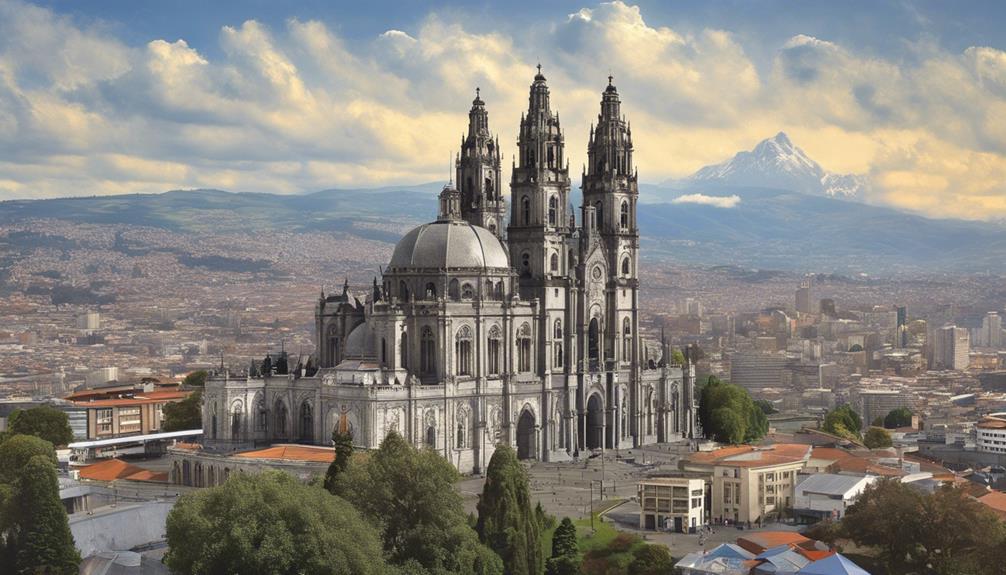
Our journey into Quito's rich heritage now focuses on the exploration of its historic landmarks, revealing the city's captivating past through architectural wonders and cultural treasures. Quito's historic landmarks are a testament to the city's vibrant history and cultural significance. The Old Town, a UNESCO World Cultural Heritage site, is a must-visit for those eager to immerse themselves in Quito's heritage. Here, visitors can marvel at the intricate churches and historical buildings that showcase the city's architectural prowess.
One iconic landmark is the Basilica del Voto Nacional, a stunning masterpiece that offers panoramic views of the city from its towering spires. For a more intimate experience, a visit to the Archbishop's Passage unveils hidden stories and architectural wonders, providing a deeper understanding of Quito's history.
To savor the fusion of cultural heritage and gastronomy, tourists can indulge in Ecuadorian chocolate, a delicacy that encapsulates Quito's rich traditions. Additionally, the Municipal Library terrace offers a unique vantage point to appreciate the city's beauty and heritage from above.
Immersive Heritage Experiences
Immersing ourselves in Quito's rich heritage involves engaging in guided museum visits that provide deeper insights into the city's cultural history. These curated tours offer a fascinating look at Quito's past, connecting visitors to the roots of Ecuadorian culture. Additionally, one can indulge in exclusive food tastings showcasing traditional Ecuadorian dishes for a unique culinary experience. This not only satisfies the taste buds but also offers a glimpse into the culinary heritage of the region.
Explore Quito's cultural heritage through artisanal traditions like Panama hats, textiles, and pottery crafted by local artisans. These handcrafted items embody generations of skill and tradition, providing a tangible link to the city's cultural richness.
Experience the stunning views of Quito from the scenic cable car, offering breathtaking panoramas of the city and its surroundings. This aerial perspective allows visitors to appreciate Quito's beauty and understand how its natural landscape has influenced its cultural development.
Delve into Quito's cultural roots by visiting historic landmarks and engaging in activities that highlight the city's unique heritage. By exploring these sites and participating in cultural events, one can gain a deeper appreciation for Quito's historical significance and cultural diversity.
Are There Any Local Superstitions or Folklore That Are Unique to Quito?
Yes, there are unique local superstitions and folklore in Quito. They add an intriguing layer to the city's culture, offering insights into its history and beliefs. Exploring these tales can provide a deeper connection to Quito's heritage.
What Are Some Lesser-Known Traditional Dishes or Drinks That Visitors Should Try in Quito?
When visiting Quito, visitors should try traditional dishes like locro de papas, a potato and cheese soup, and drinks like canelazo, a warm cinnamon and aguardiente cocktail. These lesser-known treats are sure to delight.
Can Visitors Participate in Any Hands-On Cultural Activities or Workshops During Their Stay in Quito?
Absolutely, visitors can engage in various hands-on cultural activities in Quito. From traditional craft workshops to salsa dancing classes, there are abundant opportunities to immerse ourselves in the vibrant heritage of this city.
Are There Any Hidden Gems or Off-The-Beaten-Path Historic Landmarks in Quito Worth Exploring?
Yes, there are many hidden gems and off-the-beaten-path historic landmarks in Quito worth exploring. These sites provide unique insights into the city's rich history and culture, offering a more authentic and immersive experience for visitors.
How Can Visitors Support Local Artisans and Craftsmen While Experiencing Quito's Cultural Heritage?
To support local artisans and craftsmen in Quito, we can visit markets like Mercado Artesanal or Centro Cultural Metropolitano. Engaging with these talented individuals not only preserves traditions but also fosters community connections.
In conclusion, our journey through Quito's rich heritage and experiences has been like uncovering a treasure trove of cultural wonders. Each step we took felt like peeling back layers of history, revealing the vibrant tapestry of this city.
From the colorful markets to the majestic cathedrals, every moment was a brushstroke on the canvas of our memories. Quito truly is a city where the past dances with the present, creating a masterpiece of experiences for all who dare to explore.
Cruising Capri: A Guide to the Island's Delights
A voyage through the enchanting waters of Capri offers a tantalizing blend of history, beauty, and adventure – but what lies beneath the surface will leave you spellbound.
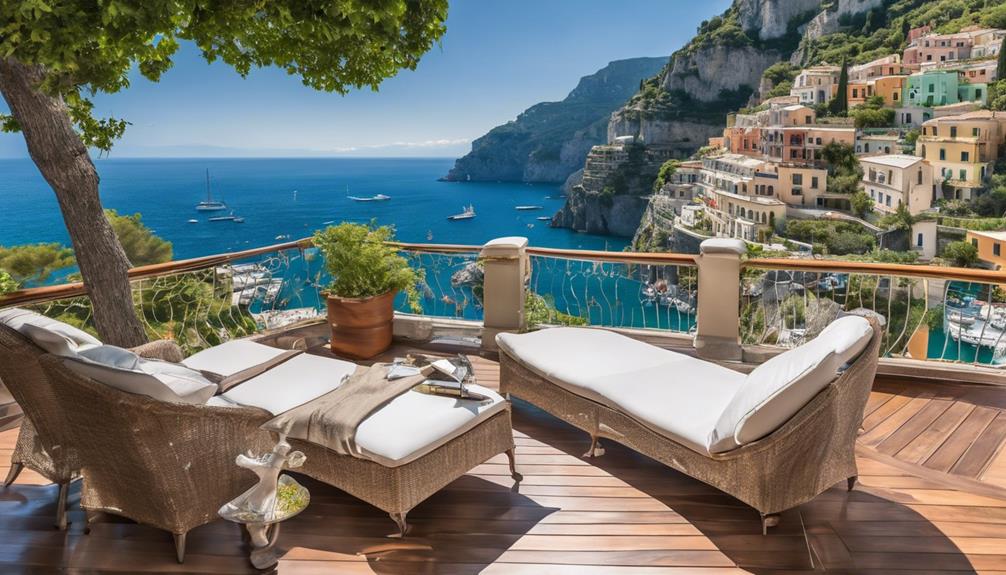
As we glide through the azure waters surrounding Capri Island, the contrast between rugged cliffs and vibrant flora creates a mesmerizing backdrop that beckons us to explore further.
But what lies beyond the shimmering surface and picturesque coastline is a tapestry of experiences waiting to be unraveled, each more captivating than the last.
From the allure of ancient ruins to the allure of modern luxury, our journey through Capri promises a blend of tradition and innovation that will leave us yearning for more.
- Capri offers a mix of luxury, history, and natural beauty.
- Indulge in local cuisine with Italian and Mediterranean flavors.
- Explore charming villages, scenic landmarks, and stunning caves.
- Engage in thrilling adventures like snorkeling and boat trips.
Island Overview and History
In our exploration of Capri's delights, let's delve into the captivating Island Overview and History. Capri, a gem in the Tyrrhenian Sea, has a history steeped in charm and allure. From the ancient Romans to modern-day travelers, the island has beckoned all with its beauty. The famous Blue Grotto, a sea cave illuminated by a mesmerizing blue light, and the enchanting Villa San Michele, with its lush gardens and panoramic views, stand as testaments to Capri's rich past.
Over the years, Capri has been a haven for artists seeking inspiration, celebrities in search of seclusion, and travelers yearning for luxury amidst limestone cliffs and crystal-clear waters. The island's rugged landscape provides a backdrop of unparalleled beauty, attracting those who appreciate a blend of nature and sophistication.
With upscale accommodations, designer boutiques, and quaint cafes, Capri offers a retreat that caters to the discerning traveler looking for a mix of relaxation and refinement. The island's history is woven into its very fabric, creating a tapestry of experiences that captivate all who visit.
Scenic Landmarks and Attractions
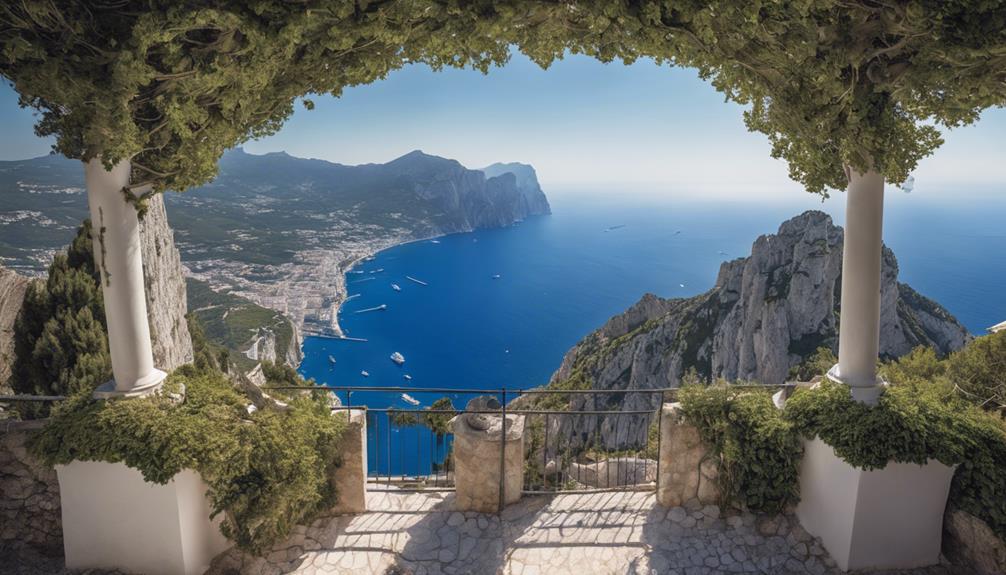
Nestled amidst the azure waters of the Tyrrhenian Sea, Capri's scenic landmarks beckon travelers with their mesmerizing beauty and allure. The iconic Faraglioni rock formations rise majestically from the sea, captivating all who lay eyes on them.
A visit to the Augustus Gardens offers a serene escape, with panoramic views of the sea and the rugged Faraglioni rocks in the distance. Don't miss the chance to embark on a boat tour to the renowned Blue Grotto, where the enchanting blue waters create a magical experience like no other.
For history and nature enthusiasts, Villa San Michele in Anacapri is a must-visit. This historic house museum boasts exquisite gardens and breathtaking views of the Gulf of Naples.
To elevate your Capri experience, hike up to Monte Solaro, the highest point on the island, and revel in the panoramic vistas of the azure waters and lush landscapes below. Whether you're taking in the sights from a Capri Boat or exploring on foot, these scenic landmarks and attractions promise unforgettable moments on the enchanting Capri Island.
Culinary Delights and Local Cuisine
Among the culinary delights awaiting visitors on Capri Island are traditional Caprese dishes showcasing the freshest local ingredients and a fusion of Italian and Mediterranean flavors. The cuisine on Capri is a true reflection of the island's essence, with dishes like Capri salad, ravioli capresi, and lemon granita taking center stage. Exploring the local specialties is a must, from indulging in seafood linguine to savoring grilled octopus and ending on a sweet note with lemon-infused desserts. The vibrant colors and bold flavors of Caprese cuisine capture the essence of the Mediterranean, offering a unique culinary experience that blends Italian influences with a touch of coastal magic.
When dining on Capri, prepare to be enchanted not only by the food but also by the charming cafes and restaurants that offer breathtaking views of the island. Whether you're enjoying a leisurely meal overlooking the sparkling sea or trying traditional dishes in a cozy trattoria tucked away in a narrow alley, every bite tells a story of Capri's rich culinary heritage. The blend of local ingredients, Mediterranean flair, and Italian passion creates an unforgettable dining experience that will leave you craving more of Capri's culinary delights.
Charming Villages and Coastal Towns

Meandering through the charming villages and coastal towns of Capri reveals a tapestry of stunning views and traditional architecture waiting to be explored. Anacapri offers a peaceful retreat with its quieter atmosphere and laid-back vibe, a stark contrast to the bustling Capri town.
The narrow streets of Anacapri are adorned with boutiques, cafes, and local artisan shops, providing a glimpse into the authentic island life and a chance to pick up unique souvenirs. Coastal towns like Marina Grande boast colorful houses, delightful seafood restaurants, and scenic waterfront promenades perfect for a leisurely stroll by the sea, immersing oneself in the serenity of the coast.
Each village and coastal town on Capri exudes its own unique charm and character, inviting travelers to soak in the captivating beauty and rich culture of the island.
Leisure Activities and Adventures
Embark on thrilling leisure activities and adventures in Capri that promise excitement and exploration amidst the island's breathtaking surroundings. Dive into the crystal-clear waters for a snorkeling experience like no other, marveling at vibrant marine life with equipment provided for your convenience. As you cruise along the coast on a boat trip, indulge in a delicious lunch with various menu options, all while soaking in the stunning views that surround you.
Capri offers more than just the usual tourist spots; discover secret locations off the beaten path, such as the enchanting Blue Grotto and other stunning caves that await your exploration. Immerse yourself in the beauty of the Faraglioni cliffs and the charm of Capri town, experiencing the island's wonders firsthand.
Whether you seek relaxation or adventure, Capri has it all – from culinary delights to hidden gems waiting to be uncovered. So set sail and let Capri's magic guide you through an unforgettable journey of discovery and wonder.
Is Capri Too Touristy?
Capri can be touristy, especially in popular areas like Capri town. Despite crowds, the island's charm shines through unique attractions like the Blue Grotto and Faraglioni rocks. Exploring off-the-beaten-path spots offers tranquility and authenticity.
Is Private Boat in Capri Worth It?
Absolutely, a private boat tour in Capri is definitely worth it. The experience offers exclusivity, flexibility, and luxury. You can explore hidden gems, enjoy personalized service, and relax in comfort, making it an unforgettable way to discover the beauty of Capri.
How Long Does It Take to See the Blue Grotto Capri?
Exploring the Blue Grotto in Capri takes 5-10 minutes. Skilled sailors guide small rowboats inside this enchanting cave. The mesmerizing blue light, caused by sunlight filtering through water, creates a magical experience. Be aware of possible closures due to tides.
What Day Is Best to Go to Capri?
Well, guess what? Tuesdays and Wednesdays are our top picks for Capri escapades. Less tourist chaos, more serenity. Plan wisely for smooth sailing with mid-week ferry options. Join us for a relaxed island exploration!
And there you have it, folks! Our journey through the stunning island of Capri has come to an end.
From diving into crystal-clear waters to indulging in mouthwatering local cuisine, we've experienced it all.
So next time you're craving a taste of paradise, hop on board and cruise through Capri for an unforgettable adventure.
Until next time, keep exploring and savoring the delights that this beautiful world has to offer!

Affiliate disclaimer
As an affiliate, we may earn a commission from qualifying purchases. We get commissions for purchases made through links on this website from Amazon and other third parties.

5 Must-Visit Temples on a Japan Cruise

Regina Charboneau: Culinary Ambassador of American Queen Voyages

Azamara Onward: Origins, Renovation, and Future Plans
Anthony Bourdain: Unconventional Culinary Icon and Global Influencer

Authentic Tacos and Local Delights: A Culinary Adventure in Cabo San Lucas

Arctic Adventure: Uncharted Destinations With Le Commandant Charcot

Authentic Art, Exciting Auctions: The Ultimate Cruise Ship Experience!

Which Celebrity Cruise Ships Have Been Refurbished

What Drinks Can You Bring On Princess Cruise

How To Turn On Cruise Control Tesla Model 3

What Is The Weather Like On A Transatlantic Cruise In April

How To Set Cruise Control Tesla Model Y
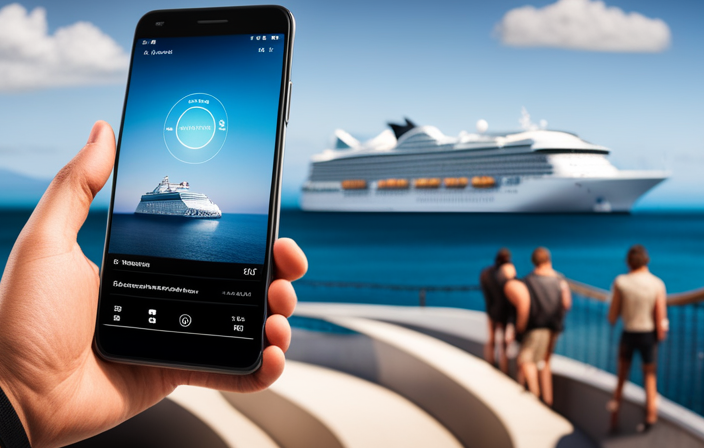
How To Check Weather For A Cruise
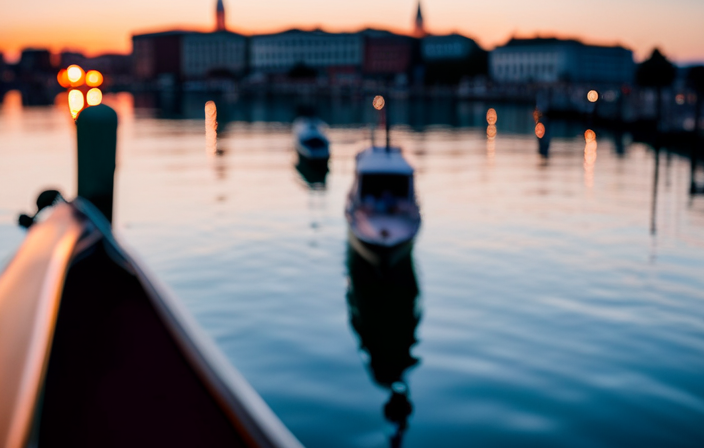
How To Get From Venice To Chioggia Cruise Terminal

How to Contact Someone on a Carnival Cruise Ship
Winter is here! Check out the winter wonderlands at these 5 amazing winter destinations in Montana
- Plan Your Trip
How Much Fuel Do Cruise Ships Hold
Published: December 20, 2023
Modified: December 28, 2023
by Emilia Kowal
- Sustainability
Introduction
Cruise ships are majestic vessels that offer travelers the opportunity to explore the world while enjoying a luxurious onboard experience. These floating resorts are equipped with state-of-the-art amenities, entertainment options, and exquisite dining experiences. However, behind the scenes, cruise ships rely heavily on fuel to power their operations and propel them through the seas.
In this article, we will delve into the fascinating world of cruise ship fuel and explore how much fuel these massive ships actually hold. We will examine the factors that affect fuel capacity, the types of fuel used, and how it is stored on board. Additionally, we will discuss the fuel consumption of cruise ships and the environmental impact it has. Finally, we will highlight some measures that the cruise industry is taking to reduce fuel consumption.
Understanding the intricate workings of cruise ship fuel is vital in comprehending the logistics and sustainability challenges faced by the industry. By gaining insight into the fuel requirements and consumption of these vessels, we can better appreciate the efforts being made to minimize their environmental impact and promote a more sustainable future for cruising.
Understanding the Fuel Capacity of Cruise Ships
Before we explore the fuel capacity of cruise ships, it’s important to understand how this capacity is determined. The fuel capacity of a cruise ship refers to the amount of fuel it can store in its tanks. This capacity varies depending on the size and design of the ship, as well as its intended itinerary and duration.
Cruise ships are typically designed to be self-sufficient during their voyages, carrying enough fuel to power all onboard systems and propel the ship for the entire duration of a cruise. This includes propulsion fuel to move the ship forward as well as fuel for electricity generation, heating, and other onboard operations.
The fuel capacity of a cruise ship is measured in metric tons or in volume, such as cubic meters or barrels. Larger cruise ships have significantly greater fuel capacity due to their longer routes and larger onboard facilities.
Factors that affect the fuel capacity of a cruise ship include:
- Vessel Size: Larger cruise ships generally have more fuel tanks and can carry a greater amount of fuel compared to smaller vessels.
- Distance and Itinerary: Cruise ships that sail longer distances or visit remote destinations require a larger fuel capacity to ensure they have enough fuel for the entire voyage.
- Speed: Ships that travel at higher speeds consume more fuel per hour. Therefore, ships that cruise at higher speeds may require a larger fuel capacity.
- Efficiency: Modern cruise ships are designed to be more fuel-efficient, which means they can travel longer distances with the same amount of fuel. This can have an impact on the required fuel capacity.
It’s important to note that the fuel capacity of a cruise ship is not fixed and can vary depending on the specific ship and its operational requirements. Cruise lines closely monitor fuel consumption and adjust refueling schedules accordingly to ensure smooth operations throughout the voyage.
Now that we have a general understanding of the factors influencing fuel capacity let’s take a closer look at the types of fuel commonly used in cruise ships.
Factors Affecting Fuel Capacity
The fuel capacity of a cruise ship is influenced by various factors that determine the amount of fuel it needs to carry. Understanding these factors is essential in managing the logistical challenges and operational efficiency of fueling these massive vessels.
1. Vessel Size: The size of a cruise ship is a key determinant of its fuel capacity. Larger ships have more space to accommodate larger fuel tanks, allowing them to carry a greater amount of fuel. This is particularly important for long-distance cruises that require extended periods without refueling.
2. Distance and Itinerary: The fuel capacity of a cruise ship is heavily influenced by the distance it will travel and the itinerary it will follow. Longer voyages or those that include remote destinations require a larger fuel capacity to ensure the ship can complete the journey without running out of fuel.
3. Speed: The speed at which a cruise ship travels also affects its fuel consumption. Higher speeds lead to increased fuel consumption per hour, meaning that ships cruising at faster speeds will require a larger fuel capacity. Cruise lines often balance speed, fuel efficiency, and travel time to optimize the overall performance of the ship.
4. Efficiency: Fuel efficiency plays a crucial role in determining the required fuel capacity. Modern cruise ships are built with advanced technologies and design features that maximize fuel efficiency. This allows them to travel longer distances with the same amount of fuel compared to older, less efficient vessels. Investing in fuel-efficient technologies helps cruise lines reduce their environmental impact and operating costs.
5. Operational Requirements: Each cruise ship has specific operational requirements that influence its fuel capacity. These requirements include factors such as onboard facilities, entertainment options, and amenities. Ships with a larger number of cabins, restaurants, spas, and other amenities will require more fuel to provide power and services to their guests.
6. Regulatory Compliance: Cruise ships must also consider regulatory requirements related to fuel capacity. Regulations may dictate safety standards, environmental considerations, and emergency preparedness. Compliance with these regulations ensures the ship can operate safely and efficiently without compromising the environment.
By taking these factors into account, cruise lines can determine the optimal fuel capacity for their ships to ensure smooth operations, minimize environmental impact, and provide an exceptional onboard experience for guests.
Types of Fuel Used in Cruise Ships
Cruise ships rely on various types of fuel to power their operations, with the specific choice often influenced by factors such as cost, availability, and environmental considerations. Let’s explore some of the common types of fuel used in cruise ships:
1. Marine Diesel Oil (MDO): MDO is a widely used fuel in the cruise industry. It is a type of distillate fuel with a lower sulfur content compared to other heavy fuel oils. MDO is typically used for cruise ship propulsion as well as for generating electricity.
2. Marine Gas Oil (MGO): MGO is similar to MDO, but with an even lower sulfur content. It is considered a cleaner alternative and is often used in restricted areas where low emissions are required. MGO is commonly used in environmentally sensitive regions or when ships need to comply with strict emissions regulations.
3. Liquefied Natural Gas (LNG): LNG is an emerging fuel source in the cruise industry due to its low emissions and environmental benefits. It is a cleaner-burning fuel compared to traditional petroleum-based fuels. LNG is stored in cryogenic tanks onboard and is gradually being adopted by select cruise lines as a more sustainable fuel option.
4. Heavy Fuel Oil (HFO): HFO is a residual fuel with a high sulfur content. It is less refined than distillate fuels like MDO and MGO. While HFO has been commonly used in the past due to its cost-effectiveness, there are growing concerns about its environmental impact. As a result, many cruise lines are transitioning away from HFO to more sustainable fuel options.
5. Biodiesel: Biodiesel is derived from renewable sources, such as vegetable oils or animal fats. It can be blended with traditional diesel fuel or used independently as a cleaner alternative. While biodiesel is not yet widely used in cruise ships, it holds potential as a more environmentally friendly fuel option in the future.
As the cruise industry embraces sustainability and seeks to reduce its environmental impact, there is a growing trend toward adopting cleaner and more efficient fuels. Cruise lines are actively exploring alternative fuel options and investing in new technologies to make their operations more sustainable for the benefit of both passengers and the environment.
Fuel Storage on Cruise Ships
Given the sizable fuel requirements of cruise ships, efficient and safe fuel storage is essential. Cruise ships are designed with dedicated spaces known as fuel tanks that are specifically built to store the fuel needed for the entire voyage. Let’s delve into the details of fuel storage on cruise ships:
Efficient fuel storage practices are essential for the smooth and safe operation of cruise ships. Cruise lines employ advanced technologies, monitor fuel consumption closely, and adhere to stringent safety protocols to ensure that fuel storage on board is optimized and in compliance with industry standards.
Cruise Ship Fuel Consumption
Cruise ships consume a significant amount of fuel during each voyage due to their size, propulsion systems, and onboard facilities. The fuel consumption of a cruise ship is influenced by various factors that impact its efficiency and operational needs. Let’s explore the key factors that contribute to cruise ship fuel consumption:
1. Vessel Size: Larger cruise ships require more fuel to propel their larger mass through the water. They have more engines and power systems that consume fuel, resulting in higher overall fuel consumption compared to smaller vessels.
2. Speed: The speed at which a cruise ship travels directly affects its fuel consumption. Higher speeds typically result in greater fuel consumption per hour. Cruise lines carefully balance speed and fuel efficiency to provide an optimal cruising experience while managing fuel costs.
3. Route and Itinerary: The distance and the specific itinerary of a cruise greatly impact its fuel consumption. Longer voyages and those that include more ports of call will require more fuel to reach each destination. Cruise lines consider fuel-efficient routing strategies to minimize fuel consumption, taking advantage of favorable currents and wind patterns.
4. Onboard Facilities and Amenities: Cruise ships offer a wide range of amenities and services to cater to passenger needs. These facilities, such as multiple restaurants, pools, theaters, and spas, require energy to operate, contributing to overall fuel consumption. Cruise lines strive to strike a balance between providing an exceptional onboard experience and managing energy usage efficiency.
5. Propulsion Systems and Technologies: The type of propulsion system used in the cruise ship affects fuel consumption. Modern ships often deploy energy-efficient systems, such as advanced diesel-electric propulsion or hybrid systems, which optimize fuel usage while reducing environmental impact. Investing in newer, more fuel-efficient technologies is a priority for cruise lines in their quest for sustainability.
It’s worth noting that the cruise industry has been actively working to improve fuel efficiency and reduce environmental impact. Cruise lines have taken initiatives such as hull and propeller optimization, waste heat recovery systems, and the use of alternative fuels like liquefied natural gas (LNG) to lower their fuel consumption and emissions.
By analyzing and optimizing fuel consumption, cruise lines strive to strike a balance between delivering an unforgettable cruising experience and minimizing their environmental footprint.
Environmental Impact of Cruise Ship Fuel Usage
The environmental impact of cruise ship fuel usage has gained significant attention in recent years. As these vessels consume massive amounts of fuel, they contribute to air and water pollution, as well as greenhouse gas emissions. Let’s explore the key environmental concerns associated with cruise ship fuel usage:
1. Air Pollution: Cruise ships emit pollutants, including sulfur oxides (SOx), nitrogen oxides (NOx), and particulate matter (PM), into the atmosphere. These pollutants can have adverse effects on air quality, human health, and ecosystems, especially in areas with heavy cruise ship traffic or near coastal communities.
2. Greenhouse Gas Emissions: The combustion of fossil fuels in cruise ship engines releases carbon dioxide (CO2), a significant contributor to global greenhouse gas emissions. These emissions contribute to climate change, leading to rising sea levels and unpredictable weather patterns.
3. Water Pollution: Cruise ships generate wastewater, including sewage, graywater, and bilge water, which can contain harmful substances such as heavy metals, oils, and chemicals. If not properly treated and disposed of, these pollutants can adversely impact marine ecosystems, endangering marine life and coral reefs.
4. Ballast Water Discharge: Cruise ships often take in ballast water to maintain stability and balance. When discharged into different ecosystems, this ballast water can introduce invasive species, disrupting the natural biodiversity and ecological balance of marine environments.
5. Coastal Infrastructure Impact: Cruise ships often visit popular coastal destinations, putting significant pressure on local infrastructure and resources. The increased demand for services can strain local waste management and water supply systems, potentially leading to environmental degradation and exceeding the carrying capacity of the destination.
Recognizing these environmental concerns, the cruise industry has begun implementing measures to mitigate the impact of fuel usage. Cruise lines are adopting sustainable practices, such as using cleaner fuels like liquefied natural gas (LNG), implementing advanced exhaust gas cleaning systems (scrubbers) to reduce emissions, and investing in energy-efficient technologies to optimize fuel consumption.
Furthermore, regulations such as the International Maritime Organization’s (IMO) sulfur emission limits and the implementation of Emission Control Areas (ECAs) have driven the industry to adopt cleaner fuels and technologies. These initiatives aim to reduce air pollution and improve the environmental performance of cruise ships.
By implementing these measures and promoting sustainable practices, the cruise industry is taking steps to minimize the environmental impact of fuel usage and foster a more sustainable future for cruising.
Measures to Reduce Fuel Consumption in Cruise Ships
The cruise industry is actively working to reduce fuel consumption and minimize its environmental impact. Cruise lines are implementing various measures and adopting innovative technologies to enhance fuel efficiency. Let’s explore some of the key strategies employed to reduce fuel consumption in cruise ships:
1. Advanced Hull Designs: Cruise ships are being designed with innovative hull shapes to reduce drag and improve hydrodynamics. By minimizing resistance from the water, these designs help ships glide through the seas with less fuel consumption.
2. Optimized Speed and Route Planning: Cruise lines employ sophisticated routing algorithms and weather monitoring systems to optimize speed and plan the most efficient routes. This allows ships to take advantage of favorable currents, winds, and sea conditions, reducing fuel consumption during the voyage.
3. Energy-Efficient Propulsion Systems: Cruise ships are increasingly equipped with energy-efficient propulsion systems. These may include diesel-electric systems, pod propulsion, or hybrid solutions that combine different power sources. These advanced systems optimize fuel usage and enhance overall energy efficiency.
4. Advanced Power Management Systems: Cruise ships employ sophisticated power management systems that distribute power based on demand. These systems prioritize energy-efficient operations, such as using power from renewable energy sources or operating generators at optimal loads, reducing fuel consumption.
5. Exhaust Gas Cleaning Systems: Cruise lines are installing exhaust gas cleaning systems, also known as scrubbers, to reduce air pollution. Scrubbers remove sulfur oxides and other pollutants from exhaust gases, ensuring compliance with emission regulations while minimizing the environmental impact of fuel usage.
6. Alternative and Low-Emission Fuels: Cruise lines are exploring the use of alternative fuels to reduce greenhouse gas emissions. This includes the use of liquefied natural gas (LNG), which has lower emissions compared to traditional fossil fuels. Additionally, research is underway to develop and test other sustainable fuel options such as hydrogen and biofuels.
7. Continuous Monitoring and Optimization: Cruise lines closely monitor fuel consumption through advanced onboard monitoring systems. Real-time data analysis allows for the identification of areas where fuel consumption can be optimized, leading to adjustments in operations for greater efficiency.
8. Crew Training and Awareness: Cruise lines prioritize crew training and awareness programs to promote responsible fuel usage practices. Crew members play a vital role in monitoring and managing energy consumption throughout the ship, ensuring that energy-saving practices are followed consistently.
By implementing these measures and investing in sustainable technologies, cruise lines are demonstrating their commitment to reducing fuel consumption and minimizing the environmental impact of their operations. The industry’s focus on fuel efficiency aligns with the broader goal of creating a more sustainable and environmentally responsible future for the cruise industry.
Cruise ships are incredible vessels that offer travelers unforgettable experiences and the opportunity to explore the world’s most stunning destinations. However, it’s important to recognize the significant role that fuel consumption plays in powering these floating resorts. Understanding the fuel capacity, types of fuel used, and the measures taken to reduce fuel consumption is crucial for the sustainability of the cruise industry.
The fuel capacity of cruise ships is influenced by factors such as vessel size, distance and itinerary, speed, efficiency, operational requirements, and regulatory compliance. Cruise lines carefully consider these factors to ensure they have enough fuel to power their voyages efficiently.
Various types of fuel are used in cruise ships, including marine diesel oil (MDO), marine gas oil (MGO), liquefied natural gas (LNG), heavy fuel oil (HFO), and biodiesel. Cruise lines are exploring cleaner and more sustainable fuel options to minimize their environmental impact.
Fuel storage on cruise ships is strategically planned with dedicated fuel tanks, double hull construction for added protection, monitoring systems, and emergency preparedness protocols. These measures ensure safe and efficient fuel storage and handling.
Cruise ship fuel consumption is influenced by vessel size, speed, itinerary, onboard facilities, and propulsion systems. The industry is actively working to reduce fuel consumption through advanced hull designs, optimized speed and route planning, energy-efficient propulsion systems, advanced power management systems, exhaust gas cleaning systems, alternative and low-emission fuels, continuous monitoring and optimization, and crew training and awareness programs.
Recognizing the environmental impact of fuel usage, cruise lines are investing in sustainable practices to mitigate their footprint. By embracing fuel-efficient technologies, exploring cleaner fuels, and adopting responsible fuel usage practices, the cruise industry is taking steps towards a more sustainable future.
In conclusion, as the demand for cruising continues to grow, it is essential for the cruise industry to prioritize fuel efficiency and environmental responsibility. By implementing measures to reduce fuel consumption and actively embracing sustainable practices, the industry can ensure that future generations can enjoy the beauty of cruising while minimizing its impact on the environment.

- Privacy Overview
- Strictly Necessary Cookies
This website uses cookies so that we can provide you with the best user experience possible. Cookie information is stored in your browser and performs functions such as recognising you when you return to our website and helping our team to understand which sections of the website you find most interesting and useful.
Strictly Necessary Cookie should be enabled at all times so that we can save your preferences for cookie settings.
If you disable this cookie, we will not be able to save your preferences. This means that every time you visit this website you will need to enable or disable cookies again.

IMAGES
VIDEO
COMMENTS
Cruise ship fuel consumption depends on the ship's size. For most vessels, the average consumption is 30-50 miles on a fuel gallon. This will be also determined by other factors using fuel.
A large cruise ship ranging in length from 900 to 1,100 feet might hold 1 to 2 million gallons of fuel. Smaller vessels, like a 440-foot-long ferry, might carry around 130,000 gallons of fuel, while a gigantic ship measuring over 1,300 feet in length can tote over 4 million gallons.
A ship’s fuel consumption depends on several factors varying from its structure to carriage capacity. Meanwhile, cruise liners have only one cargo, with the highest value amongst all, the human life! To approximate an ideal fuel consumption outline, the crew accounts for several changes.
Published: December 16, 2023. Modified: December 28, 2023. by Jilli Barahona. Share. Cruises. Sustainability. Introduction. Welcome aboard! If you’ve ever wondered about the environmental impact of cruise ships and the amount of fuel they burn, you’ve come to the right place.
14. April 2024. By. Asra. Did you know that the fuel consumed by just one cruise ship in a single day can be equivalent to what an entire small town uses? It’s a staggering statistic that highlights the immense fuel consumption of these floating cities.
The amount of fuel consumed by a cruise ship can vary greatly depending on several factors, including the ship’s size, speed, itinerary, and the technology implemented to improve fuel efficiency. On average, a mid-sized cruise ship can consume anywhere from 100 to 300 metric tons of fuel per day.
A cruise ship that holds about 1,000 passengers can spend over $15,000 a day on fuel, depending on fuel prices. A typical seven-day cruise can cost over $100,000 in fuel alone .
Sustainability. Introduction. Cruise ships are majestic vessels that offer travelers the opportunity to explore the world while enjoying a luxurious onboard experience. These floating resorts are equipped with state-of-the-art amenities, entertainment options, and exquisite dining experiences.